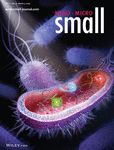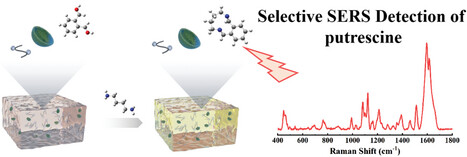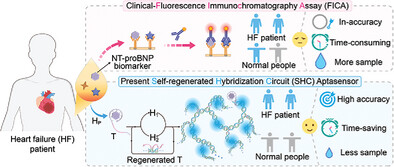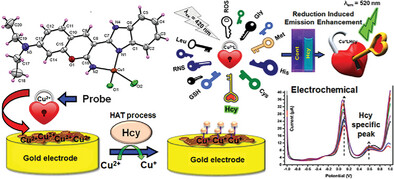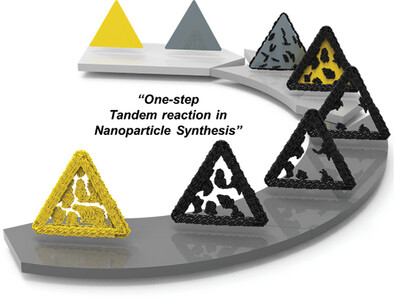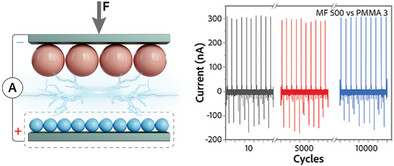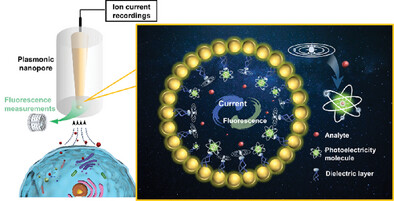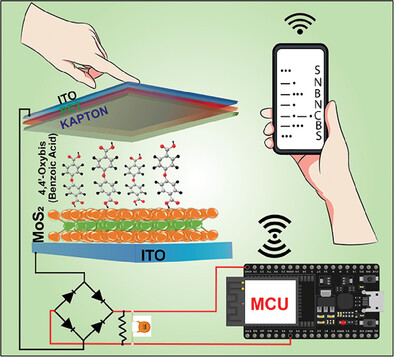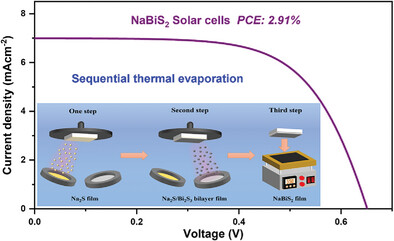Journal list menu
Export Citations
Download PDFs
Cover Picture
Bright and Stable Cyan Fluorescent RNA Enables Multicolor RNA Imaging in Live Escherichia coli (Small 9/2025)
- First Published: 04 March 2025
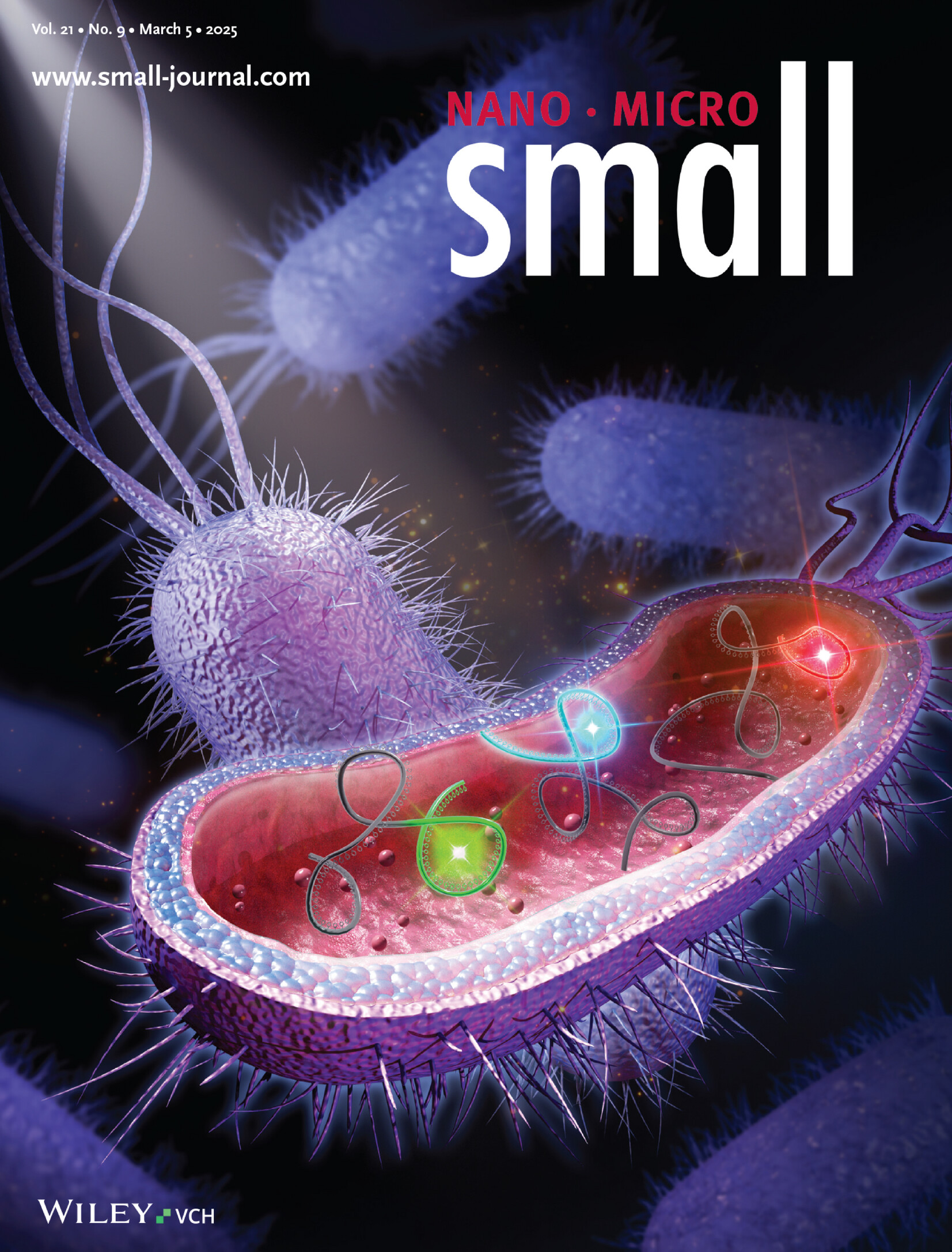
RNA Imaging
In article number 2405165, Linyong Zhu, Xianjun Chen, and co-workers designed a novel cyan fluorescent RNA (FR) called Myosotis with high cellular brightness and photostability. Myosotis is biorthogonal to Pepper and Clivia FRs, allowing multiplex fluorescence imaging of RNA in live bacteria.
Inside Front Cover
Weakly Solvating Ether-Based Electrolyte Constructing Anion-Derived Solid Electrolyte Interface in Graphite Anode toward High-Stable Potassium-Ion Batteries (Small 9/2025)
- First Published: 04 March 2025
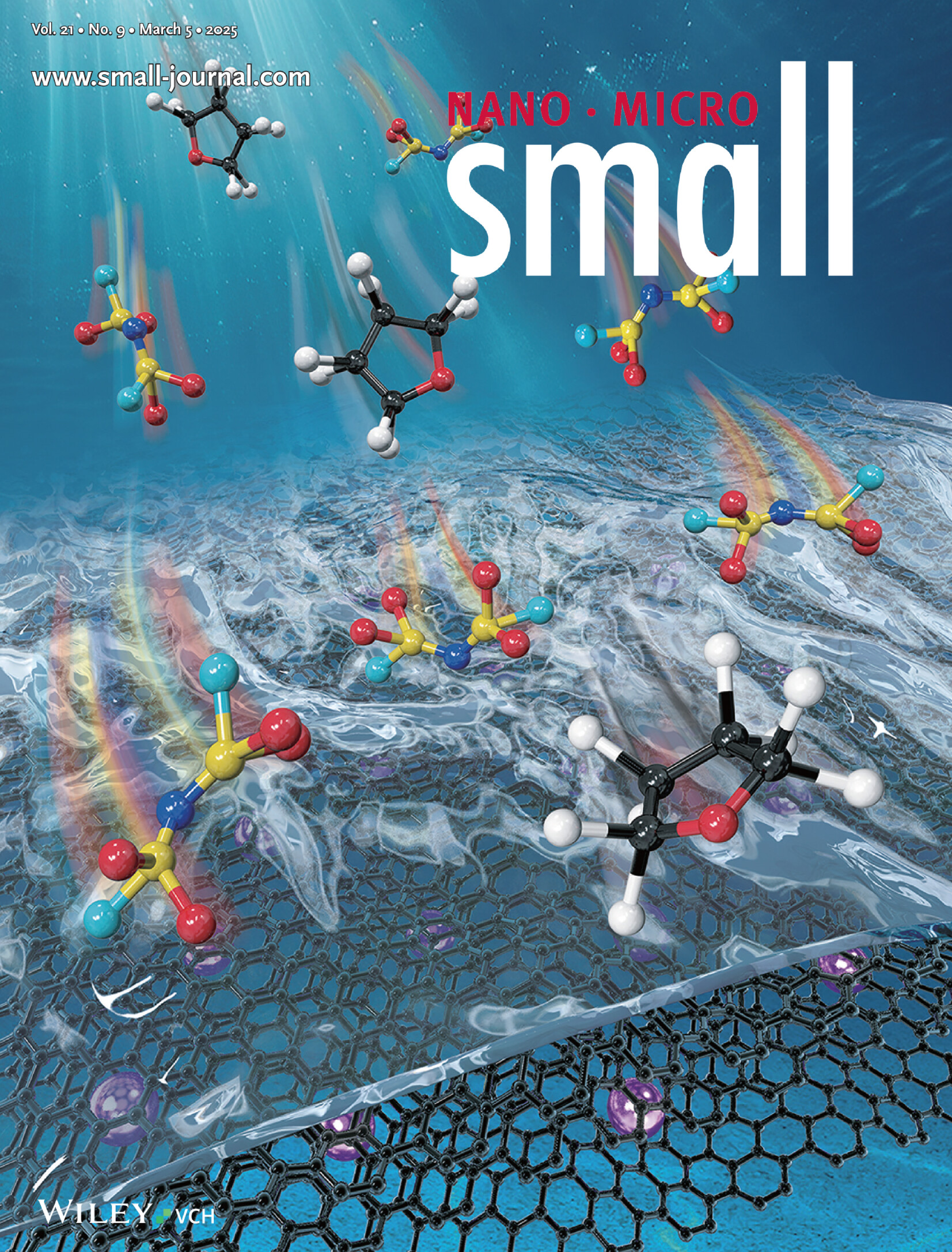
Potassium-Ion Batteries
Potassium-ion batteries are emerging as the most advanced energy storage devices. In article number 2406506, Jiangmin Jiang, Zhicheng Ju, and co-workers proposed a solvent molecular adjustment strategy by increasing spatial site resistance to construct the organic-inorganic hybrid solid electrolyte interface on the surface of low-cost graphite anode with uniform surfaces and high mechanical strength to achieve the stable cycling performance.
Inside Back Cover
Development of Turbocharging-Ability Hybrid Nanogenerators Comprising Bipolar PVDF-HFP/MXene Electrospun Composites (Small 9/2025)
- First Published: 04 March 2025
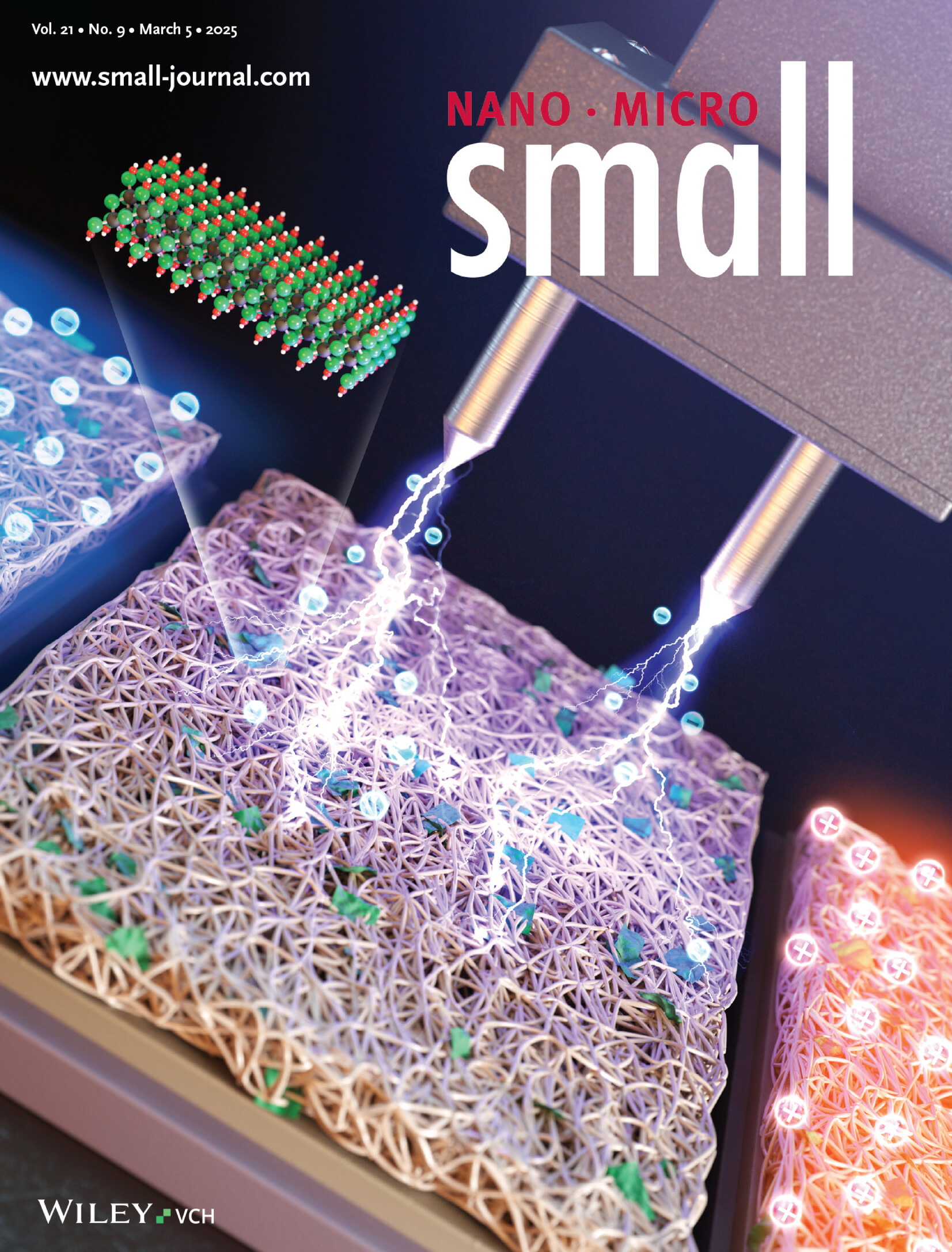
Hybrid Nanogenerators
In article number 2407001, Jin Woo Bae and co-workers introduce a groundbreaking approach to hybrid nanogenerators using electrospun PVDF-HFP/MXene composite fibers. By optimizing the MXene content to 3% (PHM3), the system ensures sustainable electrical output and the turbo-charging ability of capacitors. Remarkably, PHM3 shift from a negative to a positive surface potential via corona poling, highlighting its transformative potential in next-gen energy harvesting technologies.
Back Cover
Background-Free Imaging of Food Freshness Using Curcumin-Functionalized Upconversion Reversible Hydrogel Patch (Small 9/2025)
- First Published: 04 March 2025
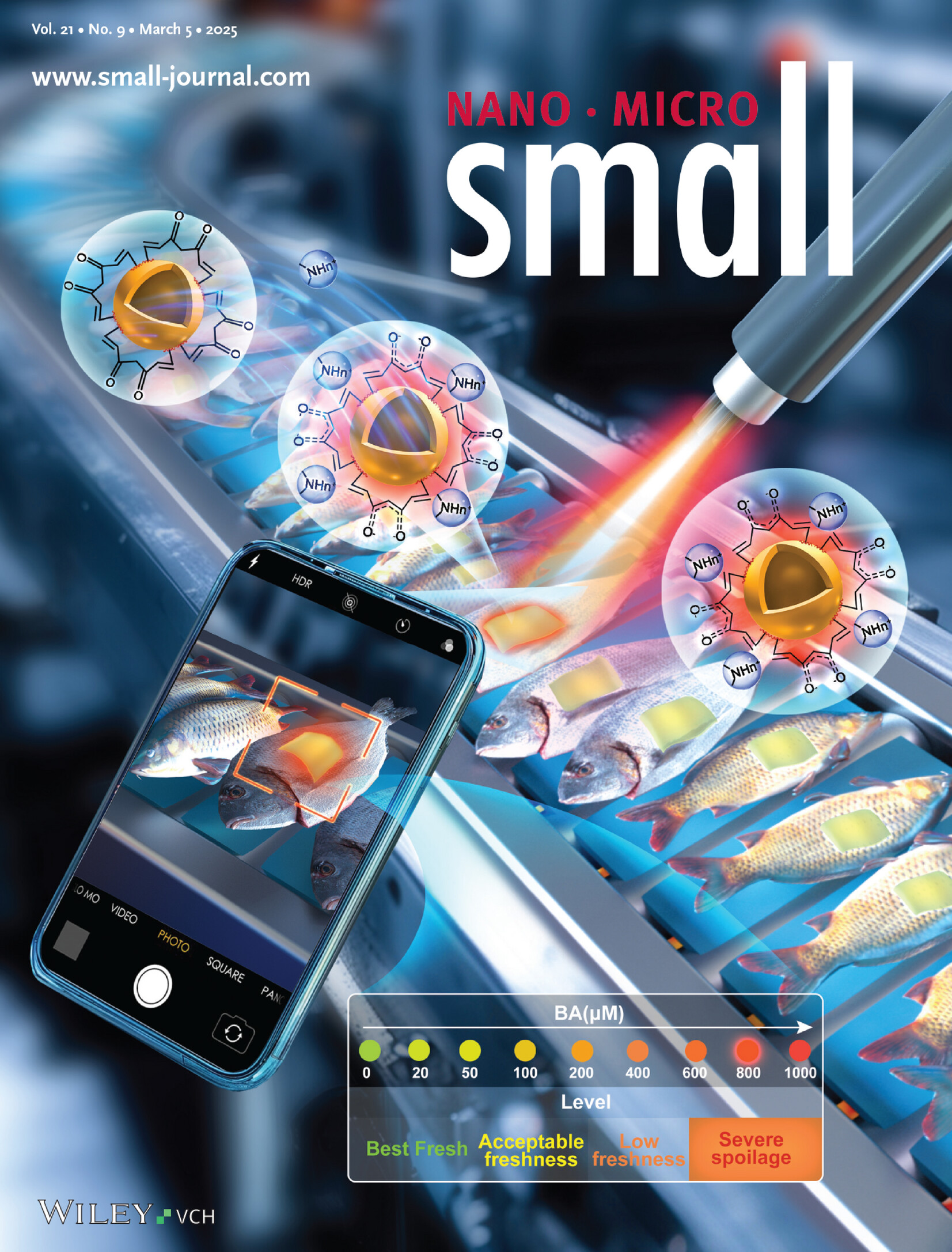
Upconversion Nanomaterials
In article number 2405812, Fan Yang, Liang Yang, and co-workers designed a curcumin-functionalized upconversion hydrogel patch for food freshness monitoring imaging by ultra-sensitive response to biogenic amines, which demonstrates the practical applicability in real-time monitoring of freshness, suggests great potential in developing optical nano-sensing strategy to ensure food safety.
Issue Information
Frontispiece
Uprising Unconventional Nanobiomaterials: Peptoid Nanosheets as a Multi-Modular Platform for Advanced Biological Studies (Small 9/2025)
- First Published: 04 March 2025
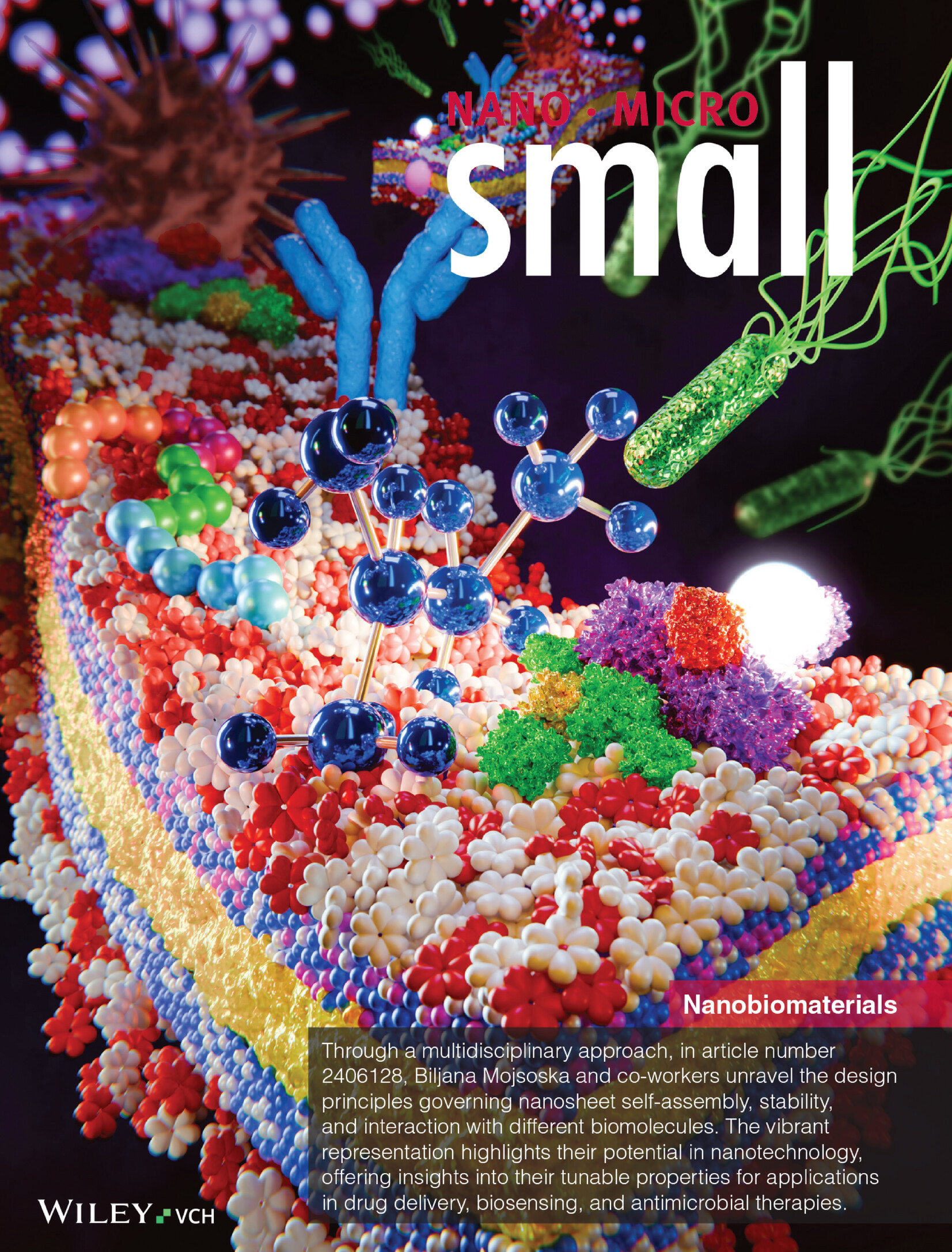
Nanobiomaterials
Through a multidisciplinary approach, in article number 2406128, Biljana Mojsoska and co-workers unravel the design principles governing nanosheet self-assembly, stability, and interaction with different biomolecules. The vibrant representation highlights their potential in nanotechnology, offering insights into their tunable properties for applications in drug delivery, biosensing, and antimicrobial therapies.
Review
Uprising Unconventional Nanobiomaterials: Peptoid Nanosheets as a Multi-Modular Platform for Advanced Biological Studies
- First Published: 01 December 2024
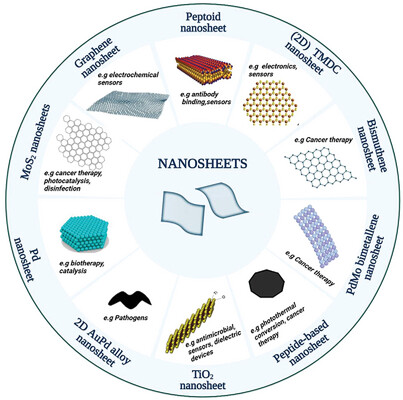
Peptoid nanosheets, bio-inspired nanomaterials, are gaining attention for their potential in biological studies. This review explores their unique assembly mechanisms, versatile chemical properties, and tunable functionalities. Emphasis is placed on their applications in biology highlighting the advantages of peptoid nanosheets over other nanomaterials. Future perspectives focus on their role in advancing biomedical research and overcoming current challenges in nanomaterial development.
Biomimetic Hydrogels – Tools for Regenerative Medicine, Oncology, and Understanding Medical Gas Plasma Therapy
- First Published: 05 February 2025
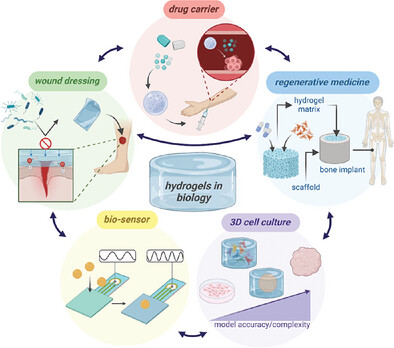
Hydrogels are receiving increased attention as innovative therapeutics for, e.g., regenerative medicine, wound dressings, and drug carriers. In addition, hydrogels are key elements in novel research models as bio-sensors and in 3D biology, which also supports unraveling spatio-temporal effector-delivery systems, such as medical gas plasma technology-derived reactive species critical in redox biology and medicine approaches.
Proteins for Hyperelastic Materials
- First Published: 05 February 2025
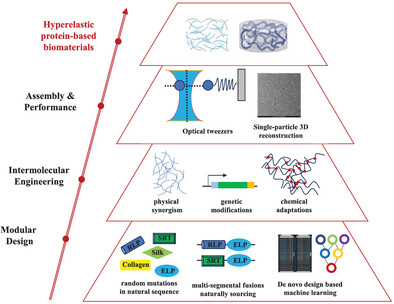
Protein-based hyperelastic biomaterials, with their remarkable elasticity, toughness, degradability, and tissue repair abilities, surpass traditional synthetics. Modular design, including machine learning, random mutations, and multi-block fusion, achieves customized proteins. Intermolecular engineering, such as physical manipulation, genetic modification, and chemical alteration, is vital for creating hierarchically structured materials. Furthermore, advances in biophysical techniques provide a more nuanced characterization of protein ensembles.
Gel-Based Electrolytes for Organic Electrochemical Transistors: Mechanisms, Applications, and Perspectives
- First Published: 03 February 2025
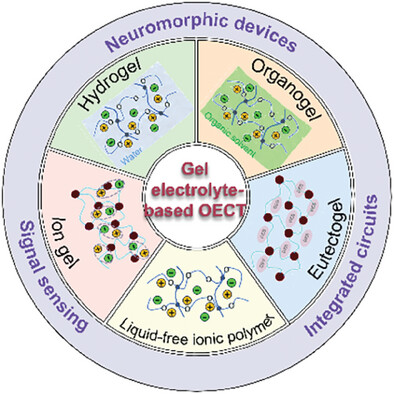
Organic electrochemical transistors (OECTs) are of great importance in bioelectronics due to high signal amplification, low voltage, and biocompatibility. Gel electrolytes, featuring a crosslinked polymer network filled with mobile ions, offer promising quasi-solid alternatives, enhancing ionic conductivity, scalability, and stability. This work reviews recent advancements, components, applications, and future perspectives in OECTs with gel electrolytes.
Nanomaterials-Enabled Sensors for Detecting and Monitoring Chemical Warfare Agents
- First Published: 26 December 2024
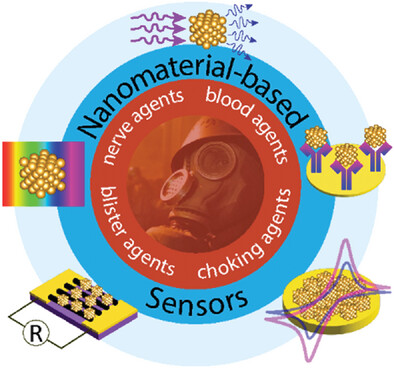
This review focuses on advancements in nanomaterial-based sensors for detecting chemical warfare agents, which remain relevant in industrial sectors such as agriculture and chemical manufacturing. It highlights key detection mechanisms, including fluorescence, chemiresistive, and electrochemical methods, while addressing critical challenges such as sensor stability, selectivity, and scalability, which are essential for improving their practical use in industrial safety and security applications.
2D MXenes: Synthesis, Properties, and Applications in Silicon-Based Optoelectronic Devices
- First Published: 16 January 2025
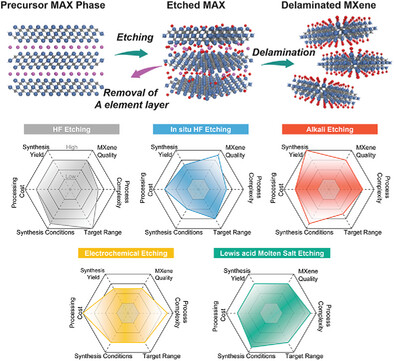
MXenes, particularly Ti₃C₂T×, are a promising class of 2D materials with exceptional properties like high electrical conductivity and tunable work functions. This review highlights their potential in enhancing silicon-based optoelectronic devices, including solar cells and photodetectors. Key focus areas include MXene composition, synthesis, properties, and their impact on device performance, along with current challenges and future opportunities for their integration into the silicon-dominated semiconductor industry.
Stimuli-Responsive Nano Drug Delivery Systems for the Treatment of Neurological Diseases
- First Published: 22 January 2025
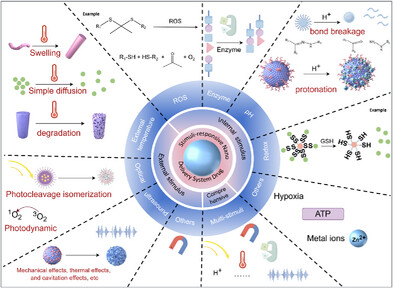
This review provides a comprehensive overview of the progress in the treatment of neurological diseases using stimulus-responsive nanodrug delivery systems. It discusses the current challenges associated with these systems and proposes future research directions and prospects, offering valuable guidance for the transition from fundamental research to clinical application.
Active Water Optimization in Different Electrolyte Systems for Stable Zinc Anodes
- First Published: 31 January 2025

Zinc metal, valued for its abundance and safety, is promising for Zn-ion batteries. Yet, corrosion, hydrogen evolution, dendrite growth, and water reactivity hinder performance. Regulating active water in electrolytes is crucial to enhancing corrosion resistance, suppressing dendrites, and improving stability, offering pathways for advancing practical applications and addressing current challenges.
Dense and Nanoporous Glasses as Host Matrices to Grow Quantum Dots for Optical and Photonic Applications
- First Published: 03 February 2025
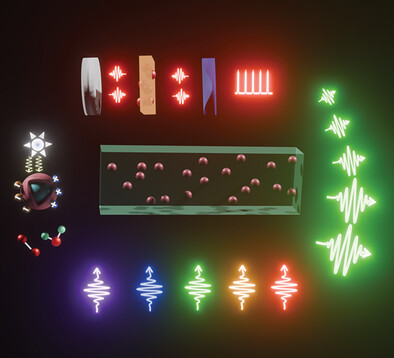
This work reviews the advances in a range of QDs embedded in both dense and nanoporous inorganic glasses. Growth techniques, the effect of glasses on the emission nature of QDs, the routes to tune and enhance emission, optical performance along with potential applications of QD glasses are discussed and an overview of related directions and future challenges is also provided.
The Extra-Tumoral Vaccine Effects of Apoptotic Bodies in the Advancement of Cancer Treatment
- First Published: 28 January 2025

This review suggests a therapeutic concept of using tumor-derived apoptotic bodies as extra-tumoral vaccines to get around the current limitations of immunogenic cell death-based therapies, especially those originating from the tumor microenvironment. This is considering these apoptotic bodies can be released into the circulation, transport antigens to dendritic cells, and initiate a T-cell immunological response.
Use of Quantum Dots as Nanotheranostic Agents: Emerging Applications in Rare Genetic Diseases
- First Published: 19 January 2025
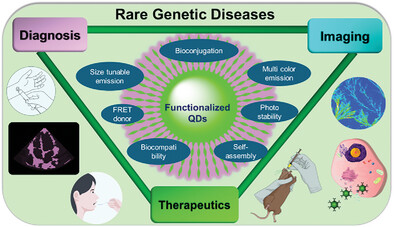
Due to the paucity of early diagnostic techniques and expensive therapeutic options, rare genetic disorders often impose severe disease burdens on modern society. However, the development in nanotechnology, especially in the field of quantum dots, offers new hope for improved theranostic approaches tuned specifically for RGDs.
Frontispiece
Combining Top-Down and Bottom-Up: An Open Microfluidic Microtumor Model for Investigating Tumor Cell-ECM Interaction and Anti-Metastasis (Small 9/2025)
- First Published: 04 March 2025
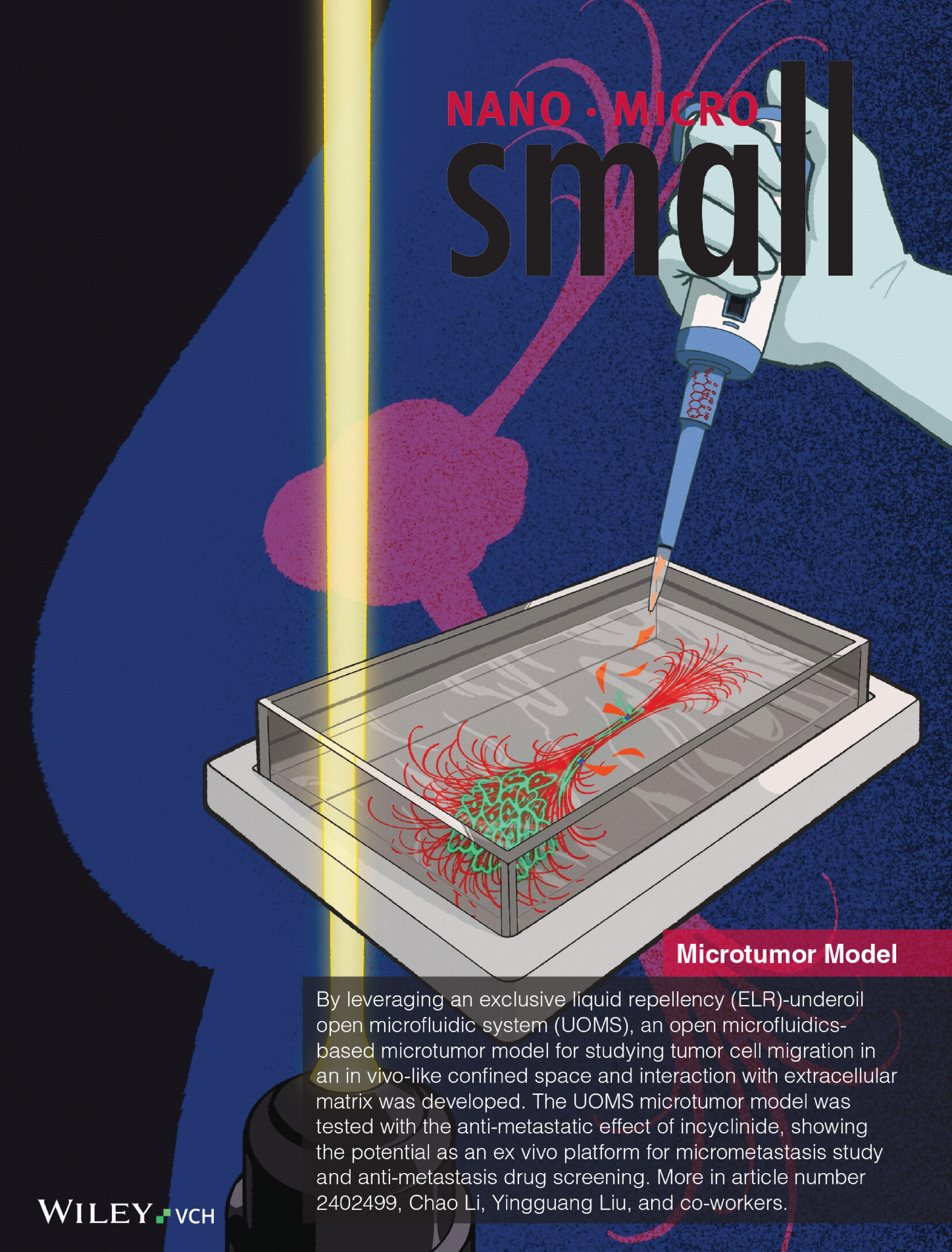
Microtumor Model
By leveraging an exclusive liquid repellency (ELR)-underoil open microfluidic system (UOMS), an open microfluidics-based microtumor model for studying tumor cell migration in an in vivo-like confined space and interaction with extracellular matrix was developed. The UOMS microtumor model was tested with the anti-metastatic effect of incyclinide, showing the potential as an ex vivo platform for micrometastasis study and anti-metastasis drug screening. More in article number 2402499, Chao Li, Yingguang Liu, and co-workers.
Research Article
Combining Top-Down and Bottom-Up: An Open Microfluidic Microtumor Model for Investigating Tumor Cell-ECM Interaction and Anti-Metastasis
- First Published: 15 January 2025
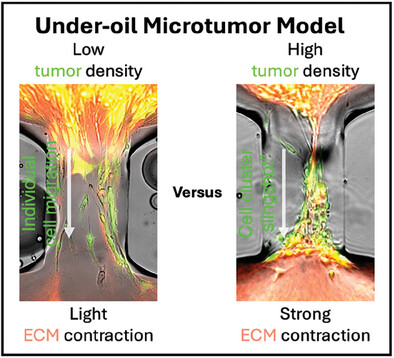
Here an open microfluidics-based microtumor model is reported for studying tumor cell-extracellular matrix (ECM) interaction and anti-metastasis drug testing. By combining top-down surface patterning and bottom-up cell-derived self-organization of ECM in an under-oil microenvironment, it allows seamless real-time physical access to the system and simulation of the dynamic microenvironment as seen in the tumor in vivo.
Frontispiece
Formulation and Recycling of a Novel Electrolyte Based on Bio-Derived γ-Valerolactone and Lithium Bis(trifluoromethanesulfonyl)imide for Lithium-Ion Batteries (Small 9/2025)
- First Published: 04 March 2025
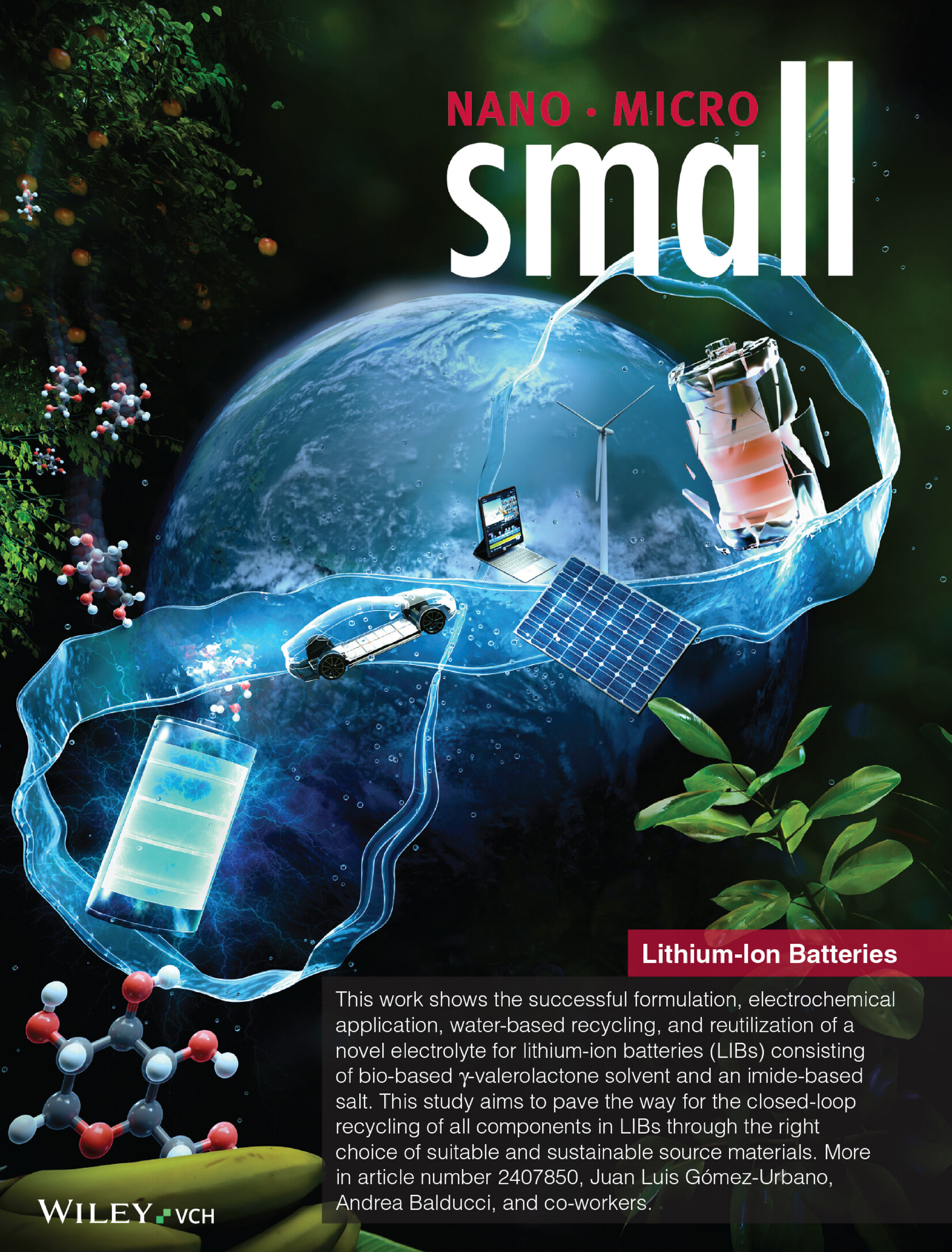
Lithium-Ion Batteries
This work shows the successful formulation, electrochemical application, water-based recycling, and reutilization of a novel electrolyte for lithium-ion batteries (LIBs) consisting of bio-based γ-valerolactone solvent and an imide-based salt. This study aims to pave the way for the closed-loop recycling of all components in LIBs through the right choice of suitable and sustainable source materials. More in article number 2407850, Juan Luis Gómez-Urbano, Andrea Balducci, and co-workers.
Research Article
Formulation and Recycling of a Novel Electrolyte Based on Bio-Derived γ-Valerolactone and Lithium Bis(trifluoromethanesulfonyl)imide for Lithium-Ion Batteries
- First Published: 15 October 2024
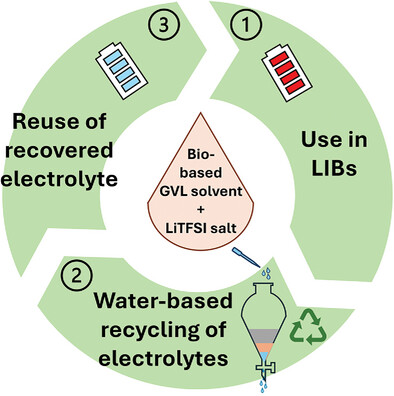
Bio-based and recyclable electrolyte: This work formulates a novel electrolyte consisting of bio-based γ-valerolactone (GVL) solvent and lithium bis(trifluoromethanesulfonyl)imide (LiTFSI) salt for lithium-ion batteries. Further, a sustainable water-based recycling method is proposed, achieving the almost complete recovery of LiTFSI and GVL. The suitability of this method is validated by the successful reutilization of the imide salt in electric double-layer capacitors.
Bright and Stable Cyan Fluorescent RNA Enables Multicolor RNA Imaging in Live Escherichia coli
- First Published: 28 October 2024

A novel cyan fluorescent RNA (FR) termed Myosotis-DBT is successfully developed with high cellular brightness and excellent photostability. Myosotis-DBT is biorthogonal to Pepper and Clivia FRs, allowing multiplex fluorescence imaging of RNA in live bacteria. Myosotis can also be used to image mRNA in live bacteria, revealing potential coupling between mRNA translation and stability.
Weakly Solvating Ether-Based Electrolyte Constructing Anion-Derived Solid Electrolyte Interface in Graphite Anode toward High-Stable Potassium-Ion Batteries
- First Published: 23 September 2024
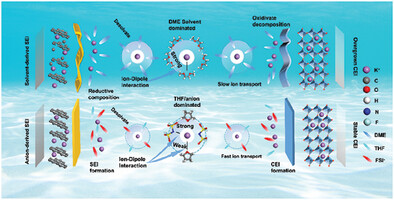
Potassium-ion batteries (PIBs) are emerging as the most advanced energy storage devices. Herein, a solvent molecular adjustment strategy is proposed to construct the organic-inorganic hybrid SEI on the surface of low-cost graphite anode with uniform surfaces and high mechanical strength. The assembled PIBs (PTCDA//Graphite) deliver a reversible capacity of 86.5 mAh g−1 and excellent cycling stability (100 cycles).
Development of Turbocharging-Ability Hybrid Nanogenerators Comprising Bipolar PVDF-HFP/MXene Electrospun Composites
- First Published: 05 November 2024
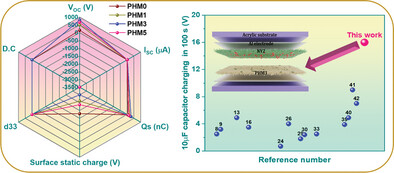
This study presents an innovative method for creating hybrid nanogenerators (HNGs) using piezo-active PVDF-HFP/MXene composite fibers made through electrospinning. By optimizing MXene content, superior electrical performance is achieved, with the optimal composite (3% MXene) enabling swift capacitor charging. Notably, PHM3 transforms from a negative to a positive surface potential of +2190 V through corona poling, showcasing remarkable potential.
Background-Free Imaging of Food Freshness Using Curcumin-Functionalized Upconversion Reversible Hydrogel Patch
- First Published: 20 October 2024
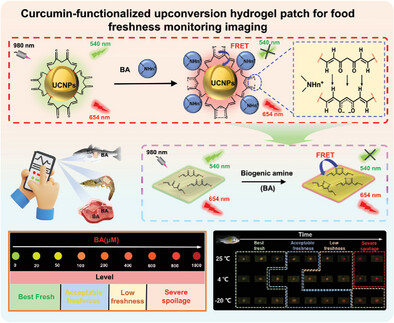
A curcumin-functionalized upconversion hydrogel patch is designed here with background-free and reversible for food freshness monitoring imaging by ultra-sensitive response to biogenic amines, which demonstrates the practical applicability in real-time monitoring of freshness, suggests great potential in developing an optical nano-sensing strategy to ensure food safety.
Borrow Strength to Exert: Low-Crystallinity Prussian Blue for Reduction Overload Enhanced Photothermal Therapy
- First Published: 03 February 2025
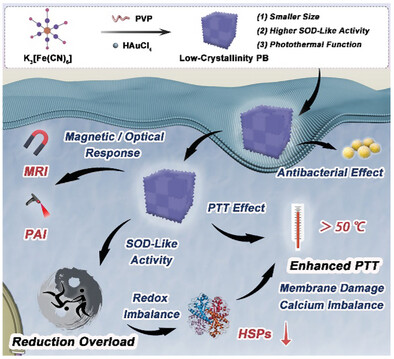
Low-crystallinity PB NPs are designed and synthesized with enhanced SOD-like enzyme activity to disrupt the redox homeostasis of tumor cells, thus enhancing the effect of photothermal therapy. Also, as-prepared PB NPs can mediate antimicrobial therapy, which is also beneficial for tumor therapeutic effect.
Holistic Investigation of Graphene Quantum Dot Endocytosis
- First Published: 02 February 2025
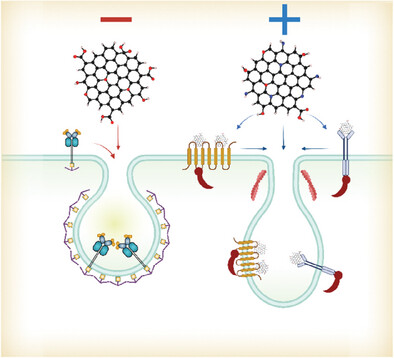
Six chemical endocytosis inhibitors are used to selectively block and analyze preferential uptake pathways of Graphene Quantum Dots (GQDs) in cancerous (HeLa) versus non-cancerous (HEK-293) cells via fluorescence microscopy. Contrary to previously perceived singular mechanism for GQD endocytosis, this work suggests that GQDs prefer a combination of multiple pathways depending on their surface charge and functional groups.
Highly Specific and Sensitive SERS Detection of Putrescine Using Au Nanobowls@Cu-MOF Embedded in a Hydrogel Nanoreactor
- First Published: 03 February 2025
Interaction Between Strain and Phase Formation in HfxZr1-xO2 Thin Films
- First Published: 03 February 2025
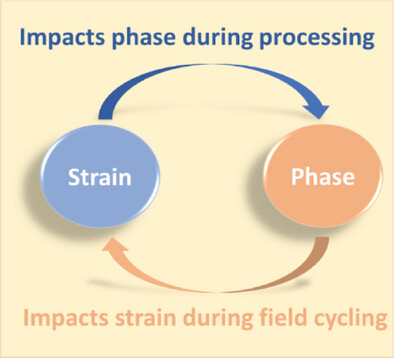
The strain from processing (e.g. lattice mismatch and CTE difference between HZO and substrate or electrode, capping effect from the top electrode, and densification of the HZO film during cooling, etc) affects the phase formation in the pristine state of HZO films. Likewise, the strain is also affected by the irreversible phase transition during electric field cycling.
Extrinsic Pseudocapacitive CoOOH Achieved by the Suppression of Its Phase Transition Triggered by S2− Doping
- First Published: 02 February 2025
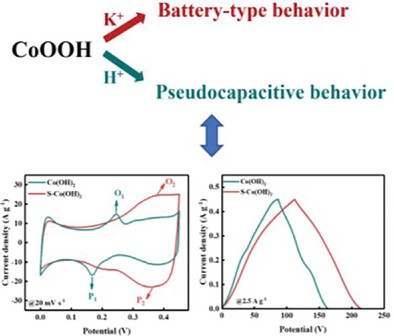
It is revealed that the K+ intercalation/deintercalation is the essential reason for the phase transition of CoOOH, leading to its battery-type behavior. Whereas, the fully protonated CoOOH produced due to the high reaction activity of S2− doped Co(OH)2 only allows the intercalation/deintercalation of H+, thereby giving rise to extrinsic pseudocapacitive behavior.
A New Combined Computational and Experimental Approach to Characterize Photoactive Conjugated 3D Polymers
- First Published: 05 February 2025
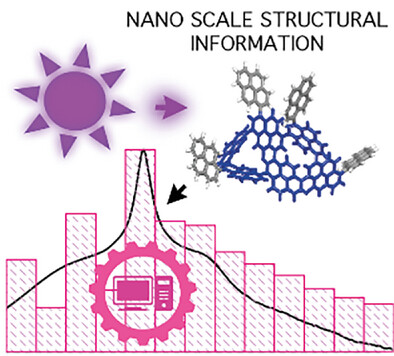
A new tractable computational protocol analyzes experimental spectra to illuminate the oligomeric scale structure of amorphous 3D polymers. Using Ambuild software, it generates representative molecular clusters, identifies common structural patterns, then calculates IR, NMR, and UV–vis spectra. The approach is validated against newly synthesised pyrene-based conjugated microporous polymers (CMPs), with UV–vis proving especially useful at understanding longer-range motifs.
Harnessing a Self-Regenerated Hybridization Circuit for Differentiating Heart Failure Patients of Varied Severity
- First Published: 05 February 2025
Full-Color Gamut White Light Emission From Mn-doped Cs3Cu2X5 Nanocrystals via Lattice Engineering
- First Published: 04 February 2025
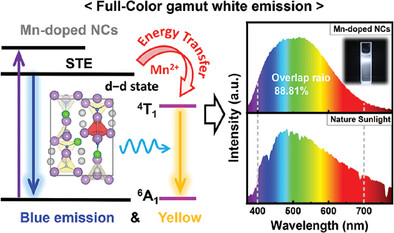
Mn-doped Cs3Cu2I5 NC-based perovskite (X = Cl, Br, and I) nanocrystals (NCs) are synthesized based on a lattice engineering strategy, which induces appropriate lattice shrinkage by replacing I− with Cl− in the Cs3Cu2I5 NC structure. The continuous white spectrum is obtained from the Mn-doped Cs3Cu2X5 NCs by the combined broad blue emission of self-trapped excitons and the yellow-orange emission of the Mn2+ d-d energy transition. A light-emitting diode based on the Mn-doped Cs3Cu2X5 NC exhibit stable white electroluminescence with CIE coordinates of (0.34, 0.32) and a correlated color temperature of 5010 K, closely matching daylight conditions.
2C-Ternary Content Addressable Memory in Memcapacitor Crossbar Array with NAND Flash Structure
- First Published: 05 February 2025
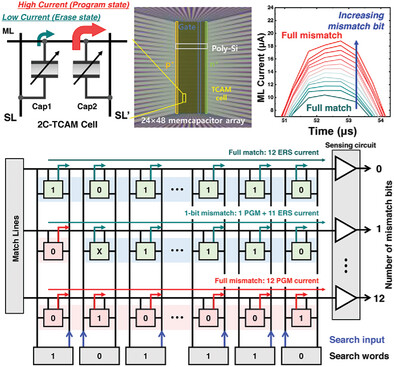
Ternary content addressable memory (TCAM), composed of two memcapacitors (2C-TCAM) based on NAND flash architecture, is experimentally demonstrated in a 24 × 48 memcapacitor crossbar array. Charging-based search scheme is presented with match-line sensing circuit. Thanks to the mature technology of flash cell and high-density array configuration, parallel and linear search operations are verified along with the degree of mismatch bit.
Crossover of Frenkel and Wannier–Mott Excitons Through Halide Composition Tuning in Mixed Halide Perovskites
- First Published: 29 January 2025
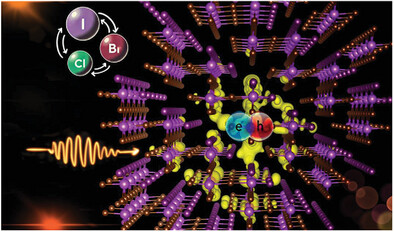
Crossover between Frenkel and Wannier–Mott Excitons is observed through the tuning of halide composition in Inorganic Halide Perovskites Cs3Bi2X9 (X = Cl, Br, I). The exciton fine structures and the exciton lifetime are determined using BSE+G0W0 considering the relativistic spin-orbit coupling (SOC). Cs3Bi2Br6I3 and Cs3Bi2Cl6Br3 show the stronger presence of Wannier–Mott and Frenkel excitonic feature distinctly.
Effect of Brief Electrical Stimulation on Cell Biomechanics in Hereditary Sensory Neuropathy
- First Published: 03 February 2025
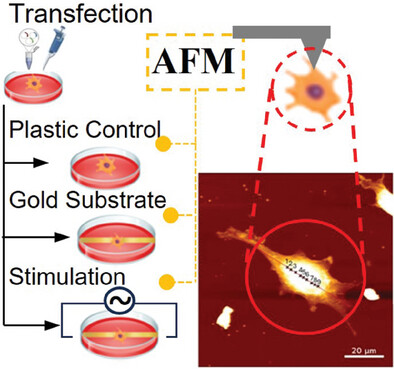
SH-SY5Y cells are used to model Hereditary Sensory Neuropathy type 1A by overexpressing wild-type and mutant SPTLC1 genes (C133W, C133Y, V144D). Mutant cells exhibit reduced stiffness, but brief electrical stimulation increases Young's modulus and decreases dissipated energy, partially reversing biomechanical defects. FEM simulations validate atomic force microscopy results, highlighting stimulation's potential therapeutic effects.
A Bio-Redox Dynamic Pickering Emulsion from Nature to Nature
- First Published: 03 February 2025
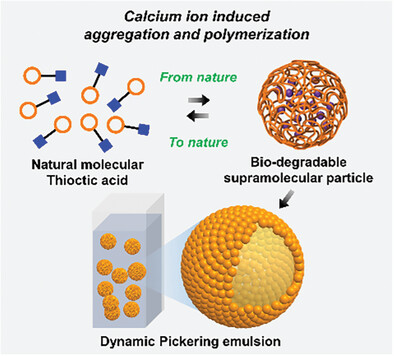
A principle of “from nature to nature” is proposed in order to solve the biosafety problem of Pickering emulsion deriving from the broad use of nano-/micro-particles. This research formulates the interfacially inactive thioctic acid into a reversible particulate emulsifier that can be metabolized by natural biological processes to eliminate their potential biohazards for the emulsion applications.
Solvent Mediated Interfacial Microenvironment Design for High-Performance Electrochemical CO2 Reduction to C2+ Products
- First Published: 16 January 2025

A suitable solvent-mediated catalyst layer is established to create a customized microenvironment for effective interfacial mass transfer in the Cu-based membrane electrode assembly MEA system. The incorporation of acetone facilitates the formation of a continuous and dispersed catalyst-ionomer network on CLs, which in turn enhances the generation of C2+ products and inhibits hydrogen evolution.
A Novel Multicompartment Barrier-Free Microfluidic Device Reveals the Impact of Extracellular Matrix Stiffening and Temozolomide on Immune-Tumor Interactions in Glioblastoma
- First Published: 03 February 2025

The innovative multicompartment barrier-free microfluidic platform replicates glioblastoma-immune interactions within a 3D extracellular matrix, revealing how matrix stiffness and temozolomide treatment shape both populations. Increased stiffness heightened tumor invasiveness while reducing immune infiltration, and temozolomide slowed immune motility but enhanced anti-tumor response. This device advances tumour modelling in vitro, offering valuable insights into glioblastoma progression and immune dynamics.
Geomimetic Interfacial Hydrothermal Synthesis of Crystalline Ionic Vinylene-Linked Covalent Organic Frameworks
- First Published: 05 February 2025
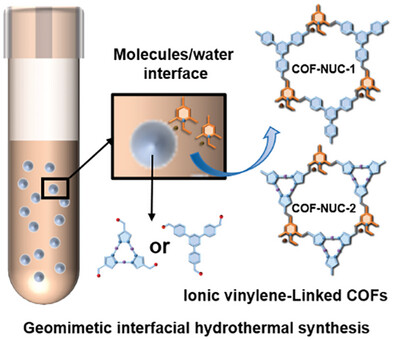
Two new ionic vinylene-linked covalent organic frameworks (COF-NUC-1 and COF-NUC-2) are synthesized by geomimetic interfacial hydrothermal synthesis for the first time. Owing to the insolubility nature of aldehyde monomers in water, the water-soluble N-ethyl-2,4,6-trimethylpyridinium bromide reacts with aldehyde monomers via the interfacial Knoevenagel condensation reaction, generating high crystalline and high chemical stable COFs.
Exploring Green Pyrotechnic Formulations and Primary Explosives with 1,3,4-Oxadiazole-Based Micro and Submicron Energetic Coordination Polymers
- First Published: 29 January 2025
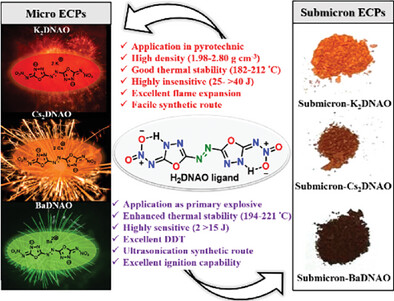
This article summarizes alkali and alkaline-earth metal-incorporated 5,5′-dinitramino-3,3′-azo-1,3,4-oxadiazole (H2DNAO)-based Energetic Coordination Polymers (ECPs). Specifically, it discusses dipotassium 5,5′-dinitramino-3,3′-azo-1,3,4-oxadiazole (K2DNAO), dicesium 5,5′-dinitramino-3,3′-azo-1,3,4-oxadiazole (Cs2DNAO), and barium 5,5′-dinitramino-3,3′-azo-1,3,4-oxadiazole (BaDNAO). These compounds have demonstrated excellent performance as green energetic materials and exhibit outstanding pyrotechnic properties.
A Single Sub-Millimetric Metasurface-Based Optical Element for Lattice Bessel Beam Excitation Enabling Brain Activity Recordings In Vivo
- First Published: 02 February 2025

A method to generate a lattice light sheet (LLS) with a single sub-millimetric optical element and to overcome some limitations of current LLS microscopes. It reduces alignment and geometrical constraints linked with the presence of multiple bulky components, it avoids major rejection or structuring of the input light otherwise necessary in a single delta-ring approach, and it decouples the numerical aperture of the LLS focusing lens from the lateral dimension of the LLS and thus the LLS lateral extension from the LLS thickness.
Superhydrophilic S-NiFe LDH by Room Temperature Synthesis for Enhanced Alkaline Water/Seawater Oxidation at Large Current Densities
- First Published: 04 February 2025

S-NiFe LDH is grown on nickel foam through electrochemical deposition and ion exchange at room temperature. The introduction of S promotes structural reconstruction, improves conductivity, and enhances anti-corrosion ability against chloride ions. S-NiFe LDH requires an overpotential of 299 mV at t 1000 mA cm−2 and operates stably at 500 mA cm−2 for 200 h in alkaline seawater, confirming its exceptional OER performance.
Fractal Scaling in the Gas-Phase Agglomeration of Nanowires
- First Published: 05 February 2025
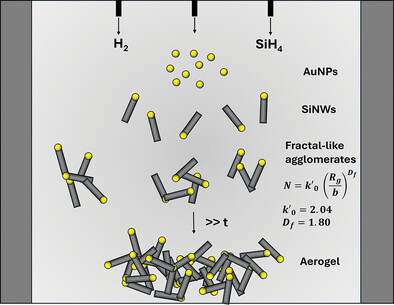
This study analyzes the structure of SiNW agglomerates produced in the gas phase by FCCVD. By studying their fractal properties, it is found that their size evolves faster upon agglomeration than for spherical particle agglomerates. It is predicted that at long residence times, the system percolates into an aerogel, enabling the foundations for direct nanotextile fabrication from the gas phase.
Evolution Driven Microscale Combinatorial Chemistry in Intracellular Mimicking Droplets to Engineer Thermostable RNA for Cellular Imaging
- First Published: 26 January 2025
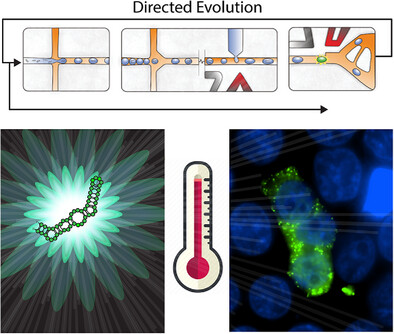
Microfluidic-based directed evolution is a powerful tool for selection of biopolymers, however they struggle in transferability to intracellular environments. The “biomimetic equivalence” principle provides a versatile and practical framework for developing biopolymers that function effectively in cells using a cell-free approach. This strategy is demonstrated by enhancing an RNA aptamer for tracking heat-induced stress granule formation in live cells.
Constructing n/n− Type Perovskite Homojunctions to Achieve High-Efficiency and Stable Printable Mesoscopic Perovskite Solar Cells
- First Published: 28 January 2025
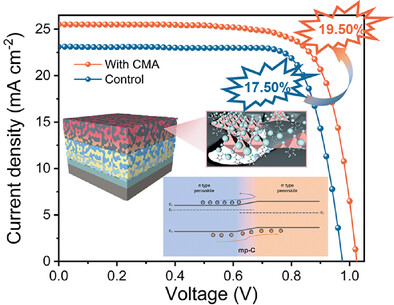
This article proposes a molecular post-treatment process designed to induces a p-type energy shift of perovskites and forms an n/n− type perovskite homojunction at the micro-interfaces between carbon electrodes and perovskites. This approach significantly enhances the separation and extraction of charge carriers, thereby increasing the power conversion efficiency of printable mesoscopic perovskite solar cells from 17.50% to 19.50%.
A Redox-Active Copper Complex for Orthogonal Detection of Homocysteine Involving Fluorescence and Electrochemical Techniques
- First Published: 23 January 2025
Elucidating a Tumor-Selective Nanoparticle Delivery Mechanism at the Colorectal Lumen–Tumor Interface for Precise Local Cancer Therapy
- First Published: 19 January 2025
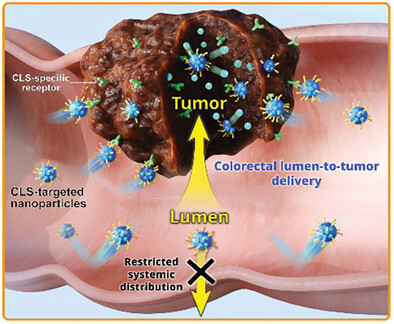
This study elucidates the nanoparticle delivery mechanism occurring at the colorectal lumen–tumor interface for highly selective local colorectal cancer (CRC)-targeted delivery without systemic distribution. The presence of accessible tumor-specific receptors enables strong interactions with CRC luminal surface-targeting ligand-functionalized nanoparticles, leading to direct and highly tumor-selective nanoparticle accumulation from the colorectal lumen to CRC tissues.
Hot Nanogap Networks-In-Triangular Nanoframes: A Strategy for Positioning Adsorbates Near Hot Spots
- First Published: 07 January 2025
Biomechanical Insights into the Proteomic Profiling of Cells in Response to Red Light Absorption
- First Published: 06 February 2025
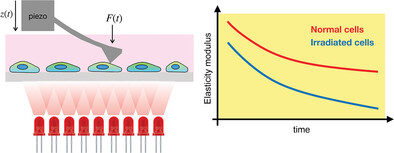
Combining atomic force microscopy and proteomic analyses reveals how red light absorption affects the viscoelastic and molecular behaviors of different cell types. Red light exposure causes fibroblasts to become softer and more fluid, accompanied by significant proteomic changes associated with immune responses and ATP-related pathways. In contrast, keratinocytes exhibit responses that vary with light intensity, while osteoblasts remain largely unaffected. These findings highlight the cell type-dependent interplay between light-induced protein expression and cytoskeletal remodeling, offering critical insights for optimizing light-based therapies in tissue repair and disease treatment.
Untwisting Strategy of MOF Nanosheets in Ultrathin Film Membrane for High Molecular Separation Performance
- First Published: 31 January 2025
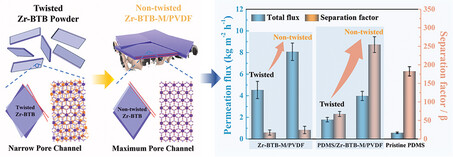
A vapor untwisting strategy is proposed to induce lattice reorganization of nanosheets and construct non-twisted ultrathin Zr-BTB nanosheet membranes. This strategy effortlessly achieves high lattice overlap and maximizes in-plane pore channels of Zr-BTB. The vertical penetrating pathways enhance the transport of large-sized molecules, addressing the challenges of difficult control over both stacking patterns and complex membrane-fabrication techniques of 2D membranes.
Insights into Homogeneous Bulk Boron Doping at the Tetrahedral Site of NCM811 Cathode Materials: Structure Stabilization by Inductive Effect on TM-O-B Bonds
- First Published: 19 January 2025
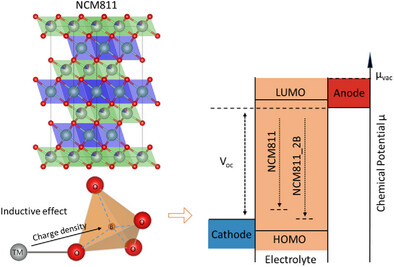
Boron can be homogeneously incorporated onto the tetrahedral site of NCM811 through co-precipitation, causing an inductive effect on transition metal-O-B bonds. This reduces oxygen release, and enhances cycling performance, achieving 210 mAh g−¹ initial capacity and 95.3% retention after 100 cycles. These findings advance boron doping insights and guide cathode design for lithium-ion batteries.
Tailoring of Selective Chemo-Responsiveness in Liquid Crystals via Organic Ionic Plastic Crystals
- First Published: 28 January 2025

We propose an integrative strategy to advance chemo-responsive liquid crystal (LC) materials via organic ionic plastic crystals (OIs). The orientational coupling of LCs with OIs, which consist of a di-cationic headgroup, aliphatic tails, and counter anions, enables the specificity and sensitivity of LCs to be precisely controlled. Especially, the crystalline property of OIs provides new physicochemical insights that distinguish this approach from prior studies.
Unveiling the Dual Active Sites of Ni/Co(OH)2-Ru Heterointerface for Robust Electrocatalytic Alkaline Seawater Splitting
- First Published: 15 January 2025
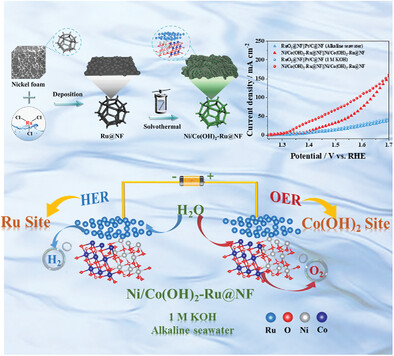
Induced by the strategy of ‘dual-HER/OER-sites-in-one’, a bifunctional Ni/Co(OH)2-Ru@NF electrode is successfully synthesized using a two-step synthesis method. The electrode exhibits desired electrocatalytic performance for alkaline hydrogen evolution rection (HER) and oxygen evolution reaction (OER). The potentials@10 mA cm−2 of Ni/Co(OH)2-Ru@NF for overall alkaline water and seawater splitting are only 1.36 and 1.41 V, respectively, surpassing those of commercial RuO2@NF and Pt/C@NF.
Picofluidic Electro-Osmosis Measurement of Cell Membrane Mechanical Properties
- First Published: 03 February 2025
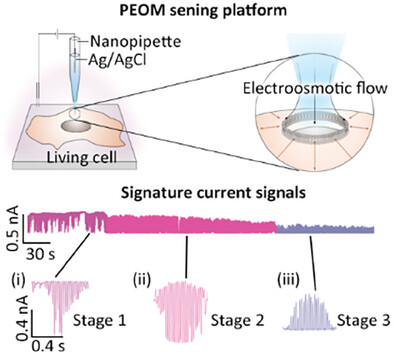
A direct and efficient sensing strategy for evaluating cell membrane mechanical properties is achieved via picofluidic electro-osmosis measurement (PEOM). Periodic cell membrane vibration modes are observed from current traces, thus effectively revealing the mechanical properties of living cell membranes during different bioprocesses.
{110} Surface-Exposed Bi3.15Nd0.85Ti3O12 Ferroelectric Nanosheet Arrays on Porous Ceramics as Efficient and Recyclable Piezo-Photocatalysts
- First Published: 27 January 2025
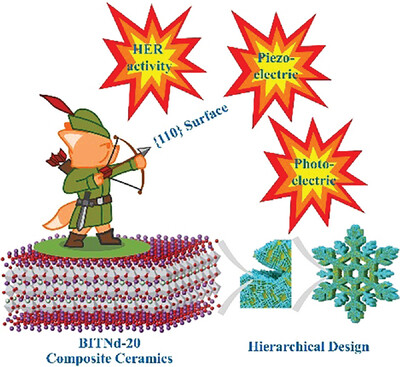
This study introduces a hierarchical design strategy for creating nanosheet-modified porous piezoelectric ceramics. By incorporating nanosheets with exposed {110} surfaces, the HER activity, piezoelectric response, and photoelectric response of the porous ceramics are enhanced. This results in high efficiency, stability, and durability in piezo-photocatalysis, while also overcoming secondary pollution issues of water associated with the complex recovery of powder-based catalysts.
Granular Interfaces in TENGs: The Role of Close-Packed Polymer Bead Monolayers for Energy Harvesters
- First Published: 05 February 2025
Infinite Organic Solid-Solution Semiconductors with Continuous Evolution in Film Morphology, Crystalline Lattice and Electrical Properties
- First Published: 16 January 2025

Organic solid-solution semiconductors are achieved by substituting host molecules in crystalline lattice at random with arbitrary ratio, overcoming the drawbacks of current organic composite semiconductors. Consequencely, continuous regulation is achieved in film morphology, structure and electronic properties, which is an efficient strategy to accelerate the advancement of diverse electronic and optoelectronic devices.
Waterborne Recoatable Transparent Superhydrophobic Coatings with Excellent Self-Cleaning and Anti-Dust Performance
- First Published: 19 January 2025
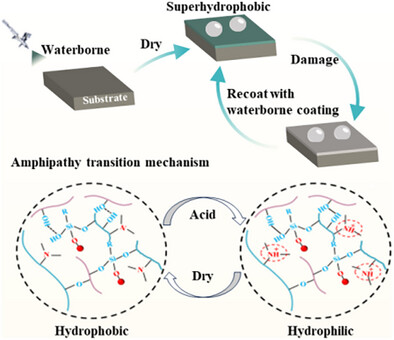
Superhydrophobic surfaces are famous for their lotus-leaf-like water-repellent properties and wide applications. However, most conventional superhydrophobic coatings involve environmentally harmful organic solvents and suffer from poor mechanical durability. To solve these issues, a waterborne recoatable superhydrophobic coating is developed. The damaged superhydrophobic coatings can be healed by recoating the waterborne coating.
Long-Term Diabetic Retinopathy Treatment Using Silicon Nanoneedles
- First Published: 05 February 2025
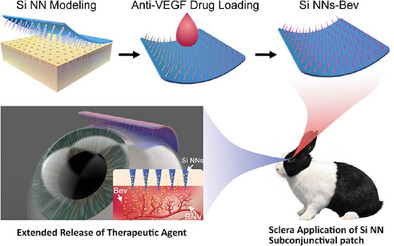
We developed a biodegradable silicon nanoneedle (Si NN) patch for diabetic retinopathy treatment, delivering bevacizumab via a tear-soluble subconjunctival platform. The patch dissolves within one minute, embedding Si NNs into the sclera for year-long drug release. A 12-month study showed over 82% reduction in retinal neovascularization, reduced leakage, minimal recurrence, and improved patient comfort compared to conventional therapies.
A Self-Amplifying Photodynamic Biomedicine for Cascade Immune Activation Against Triple-Negative Breast Cancer
- First Published: 23 January 2025
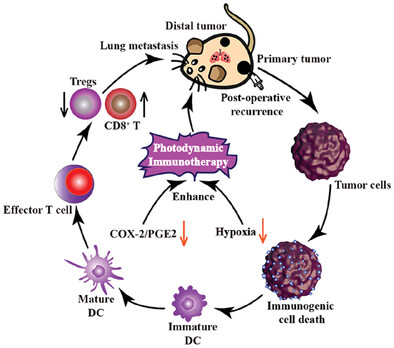
A self-amplifying nanoplatform is rationally engineered to initiate the cascade immune activation by alleviating hypoxia and inhibiting COX-2/PGE2 signaling, thereby enhancing photodynamic therapy. The photodynamic immunotherapy effectively triggers the infiltration of cytotoxic T-lymphocytes, while concurrently suppressing regulatory T-lymphocytes into the tumor. This study is expected to inform the clinical application of photodynamic immunotherapy for triple-negative breast cancer.
Ionic Strength-Induced Compartmentalization for Nanogel-in-Microgel Colloids
- First Published: 15 January 2025

The ionic strength-induced compartmentalization is a facile and robust method to precipitate particles such as charged or uncharged nanogels inside aqueous microfluidic droplets prior to polymerization. The use of different materials for the compartment and the surrounding network can facilitate anisotropic shape change of the resulting colloids. This method opens new pathways for compartmentalized particles for applications like drug delivery.
Tailored Supramolecular Additives to Control the Crystallization Process and Morphology of MAPbI3
- First Published: 05 February 2025
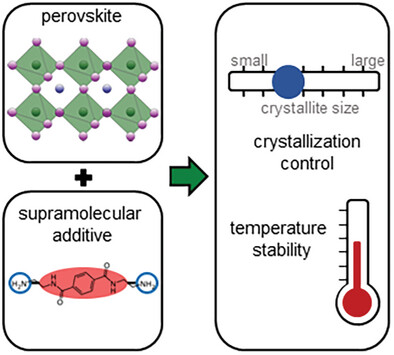
A method is presented to control MAPbI₃ nanostructure during blade coating by using a tailored supramolecular additive. This additive interacts with Pb2⁺ ions through Lewis acid-base adducts and attaches to perovskite grain boundaries via peripheral amines and strong hydrogen bonding. Single-molecule interlayers form between MAPbI₃ crystals, enhancing film stability through supramolecular interactions among the additive molecules.
Role of Mesoporosity in Hard Carbon Anodes for High-Energy and Stable Potassium-Ion Storage
- First Published: 08 January 2025
Enhanced Mechanical Properties in Bulk Nanograined Ni with High-Density Fivefold Twins
- First Published: 23 January 2025
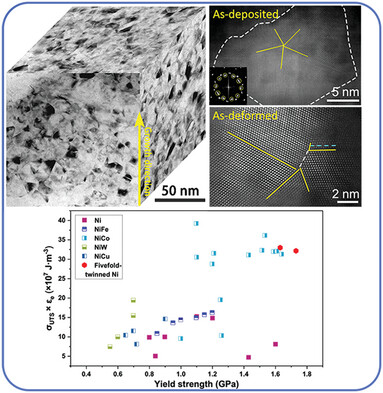
Bulk fivefold-twinned nanograined Ni, synthesized via electrodeposition, demonstrates remarkable mechanical performance with a tensile strength of 2.15 GPa and 15% elongation. Plastic deformation involves partial dislocation activity on twin boundaries, causing fivefold-twin splitting and grain refinement. Size-dependent nucleation stress for partial dislocation drives strengthening and strain hardening, highlighting the potential of fivefold twins for advanced material design.
Designing Fluorescent Interfaces at Hotspots in a Plasmonic Nanopore for Homologous Optoelectronic Sensing
- First Published: 20 January 2025
Phase Coexistence Induced Giant Dielectric Tunability and Electromechanical Response in PbZrO3 Epitaxial Thin Films
- First Published: 17 January 2025
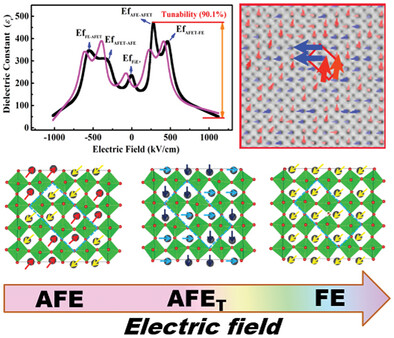
A phase coexistence of antiferroelectric and tetragonal-like phases is discovered in epitaxial PZO thin films across thicknesses ranging from 16 to 110 nm. Ultrahigh dielectric tunability of 90.1% is achieved in 49 nm thick sample with a distinct shoulder-cape-shaped behavior. Through STEM and theoretical calculations, an intermediate phase is identified with vertically diagonal “↑↑↓↓” dipole arrangement pattern during AFE-to-FE phase transition.
Solar-Active Carbon Nitride Film Integrated by Free Radical Copolymerization for Photocatalytic Indoor Air Purification
- First Published: 20 January 2025
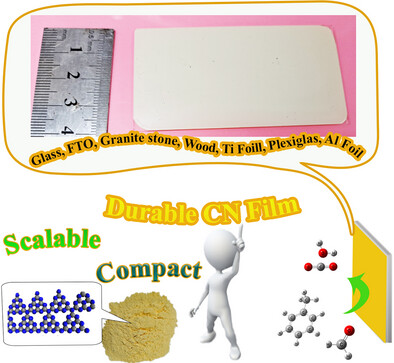
A unique, efficient, and scalable method is reported to immobilize CN powder on various substrates. It results in a stable, smooth, uniform, and compact thick film. The smooth, non-oxidizable, and well-defined continuous coating exhibits excellent adherence and durability. The resulting film shows outstanding photodegradation performance toward air pollutants.
Deprotonation-Constructed Instant Gelation Coating for Staphylococcus Disinfection and Preservation of Fresh Food in Multiple Scenarios
- First Published: 31 January 2025
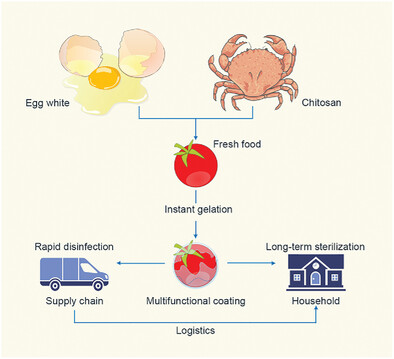
Egg whites and chitosan can be employed to instantly construct multifunctional hydrogel coatings on the surface of fresh food through deprotonation. The coating offers food preservation and can be modularly substituted for antibacterial agents to meet diverse requirements in various scenarios. For instance, it can be employed for rapid disinfection within the supply chain and long-term household sterilization, decreasing foodborne illnesses.
Sustainable Electrospun Hybrid Nanofibers for Triboelectric Nanogenerators
- First Published: 29 January 2025
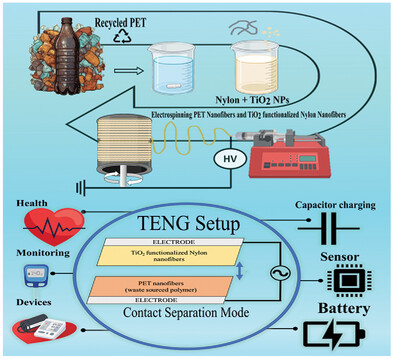
Fabrication of advanced hybrid materials from recycled polymer provides an environmentally friendly and economical platform for TENG. TENG is a sustainable approach to capture energy for a wide range of applications. Using electrospinning and recycled materials, a facile strategy is provided to fabricate hybrid nanofibers for efficient TENG devices. The TENG module can power health monitoring devices, charging capacitors, sensors, and batteries.
Formation of CdTeS Prenucleation Clusters at Elevated Temperatures and Transformation to Magic-Size Clusters at Room Temperature
- First Published: 06 February 2025

Chemical self-assembly results in the formation of prenucleation clusters (PNCs), which are the precursor compound (PC-381) of CdTeS MSC-381 and relatively transparent. Physical co-self-assembly among the three precursors of Cd and Te and S (Step 1a) causes the broadening of the 113Cd resonance signal, which shifts toward the down-field direction upon the development of Te−Cd−S covalent bonds inside each assembly (Step 1b).
Commercial SiO Encapsulated in Hybrid Bilayer Conductive Skeleton as Stable Anode Coupling Chemical Prelithiation for Lithium-Ion Batteries
- First Published: 10 January 2025
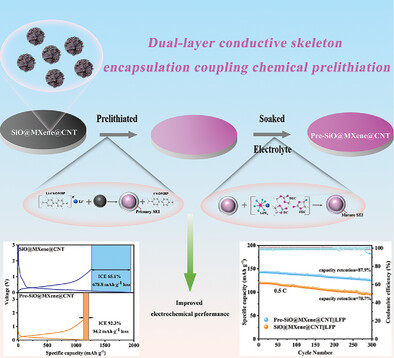
The SiO@MXene@CNT anode fabricated through electrostatic self-assembly exhibits excellent mechanical and electrochemical properties due to its unique and effective dual conductive framework of CNT and MXene. Moreover, chemical prelithiation significantly enhances the initial Coulombic efficiency and cycling stability, making it a highly promising and innovative anode material for advanced lithium-ion batteries.
Integration of Asymmetric Multi-Path Hollow Structure and Multiple Heterogeneous Interfaces in Fe3O4@C@NiO Nanoprisms Enabling Ultra-Low and Broadband Absorption
- First Published: 23 January 2025
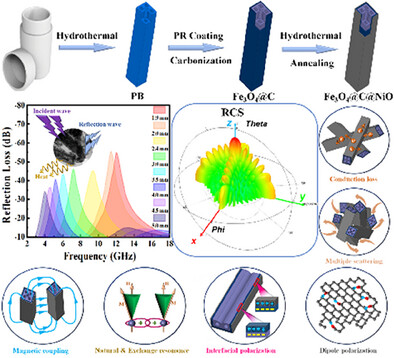
In this study, 1D Fe3O4@C@NiO nanoprisms with unique tip shapes, asymmetric multi-path hollow inner cavity, and multiple core–shell heteroepitaxy structure are designed based on the impedance matching, which has the RLmin as low as −55.8 dB at 2.0 mm and achieves extremely wide effective absorption bandwidth of 9.9 GHz at 4.9 mm, and realizing the efficient low-frequency absorption (3.8–7.9 GHz at 4.0 mm) almost completely covers the 5G band.
Unveiling Aqueous Potassium-Ion Batteries with Prussian Blue Analogue Cathodes
- First Published: 19 January 2025
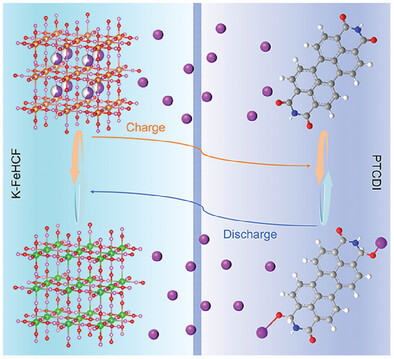
An aqueous potassium-ion battery is synthesized with Prussian blue analogs cathode and perylene-3,4,9,10-tetracarboxylic anode, which delivers a high energy density of 52.0 Wh kg−1 and stable life >4000 cycles. The in situ XRD, in situ Raman, ex situ XPS, and ex situ FTIR are used to synergistically investigate the potassium storage mechanism, which provides a significant reference for the development of aqueous potassium-ion batteries.
Catalytic Cu2O/Cu Site Trades off the Coupling and Etching Reactions of Carbon Intermediates for CO2-Assisted Graphene Synthesis
- First Published: 27 January 2025
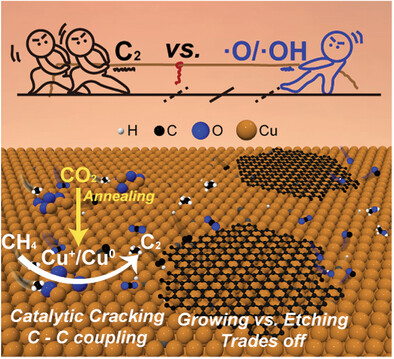
A CO2-participated annealing procedure is designed to construct the catalytic Cu+/Cu0 sites on the Cu foil. These Cu2O/Cu species can catalyze the CH4 decomposition and C─C coupling to form C2 intermediates. In addition, the catalytic Cu2O/Cu sites allow the growing rate of graphene driven by C2 intermediate faster than the etching rate of O-containing species, to grow hexagonal and uniformly monolayered graphene domains.
DNA Origami Framework-Based Spatial Nanochip for Circular ssDNA Assembly and Data Storage
- First Published: 23 January 2025
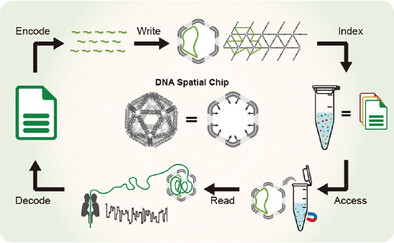
A 3D DNA spatial chip (DSC) based on an icosahedral framework is designed and assembled for high-density information storage. The complete workflow, from data encoding through c-ssDNA assembly (information writing), file archiving, random access retrieval from a DSC library, rolling circle amplification, sequencing (information reading), and final data decoding, is illustrated.
Amorphous Ni(OH)2 Coated Cu Dendrites with Superaerophobic Interface for Bipolar Hydrogen Production Assisted with Formaldehyde Oxidation
- First Published: 13 January 2025

The Cu@Ni(OH)2/CF is constructed by the crystalline Cu and amorphous Ni(OH)2. The amorphous-crystalline interface enhances the activity of the Cu and promotes the adsorption of HCHO and OH− species. The modification of Ni(OH)2 results in aerophobic states on the Cu@Ni(OH)2/CF surface, facilitating the transport of liquid-phase species on the electrode surface and accelerating the release of H2.
Photoresponsive Bio-Heterojunctions Eliciting Immunogenicity to Prevent Infection Recurrence and Accelerating Chronic Wound Regeneration
- First Published: 26 January 2025
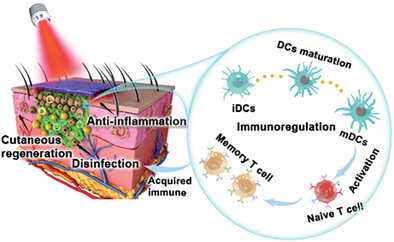
Photoresponsive bio-Heterojunctions can release ROS to combat infections and enhance innate immunity while also scavenging excess ROS to prevent accumulation that can impair the establishment of adaptive immunity. In contrast to existing ROS-based anti-infection treatment strategies, this study focuses more on the regulation of the immune system following anti-infection therapy, to combat recurrent and chronic infectious diseases.
Side Reaction Turned Positive: Synchronous OER Manipulating the Electrocatalytic Properties of Anodic Electrodeposited Lead Dioxide
- First Published: 22 January 2025
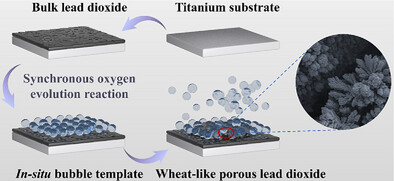
Introducing synchronous oxygen evolution reaction to manipulate conventional anodic electrodeposition process confers porous morphology in situ and a large number of defects to PbO2 coating in a few seconds, effectively enhancing the electrocatalytic oxidation performance of PbO2 electrode in a simple, flexible, and fast way.
Controlled Delivery of MTX from Thermosensitive Hydrogels Using Au Nanorods for Enhanced Therapeutics of Psoriasis via Improving Stratum Corneum Penetration
- First Published: 10 January 2025

This sprayable hydrogel-based platform can utilize NIR as a “trigger switch” to release MTX precisely. Meanwhile, the rapid phase transition enhanced the penetration of the hydrogel formulation through the stratum corneum upon NIR light irradiation and prolonged skin retention after returning to a gel state.
Skin-Inspired and Self-Powered Piezoionic Sensors for Smart Wearable Applications
- First Published: 09 January 2025
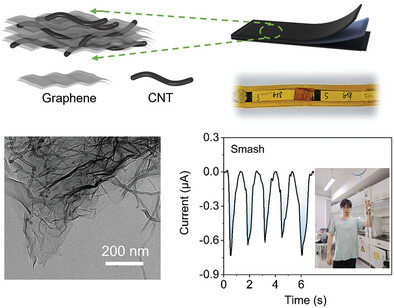
A durable nanocomposite with hierarchical structure is developed as electrode material for flexible piezoionic strain sensors. The nanocomposite provides abundant channels for ultrafast ion transfer during piezoionic sensation process, and then greatly improves piezoionic performances of sensors. The as-prepared flexible skin sensors with superior mechanical, electrical, and electrochemical properties are employed in wearable smart applications.
Surface Engineered MoS2-Based Novel Vertical Triboelectric Nanogenerator (V-TENG) for Wireless Information Processing
- First Published: 29 January 2025
Cross-Referencing Multifluid Metabolic Profiles on Hollow Dodecahedral Nanocages for Enhanced Disease Status Identification
- First Published: 05 February 2025
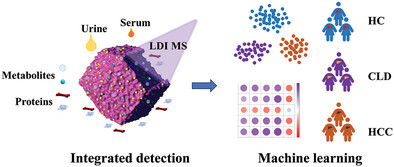
Based on Au-decorated hollow dodecahedral metal oxide nanocages-assisted LDI MS, high-throughput extraction of urine and serum metabolic fingerprints are achieved and an effective and precise metabolic profiling platform is established for the integrated detection of chronic liver disease (CLD) and accurate diagnosis of hepatocellular carcinoma (HCC) by machine learning.
Formation and Evolution of the Solid Electrolyte Interphase on Silicon Electrodes from Fluorine-Free Electrolytes
- First Published: 05 January 2025
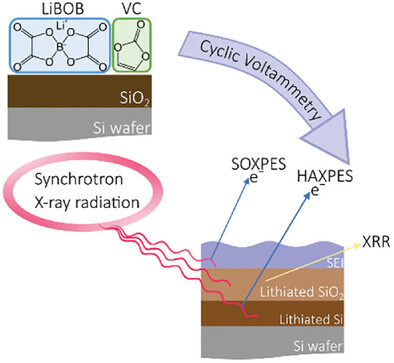
This study investigates the surface layer evolution of a silicon wafer upon cycling, using the fluorine-free electrolyte salt LiBOB with and without the additive vinylene carbonate. Operando X-ray reflectivity and ex situ X-ray photoelectron spectroscopy suggest three layers building up and provide structural and chemical insights into the solid electrolyte interphase formation and silicon wafer lithiation.
A Fused Membrane-Camouflaged Biomimetic Nanosystem for Dual-Targeted Therapy of Septic Arthritis
- First Published: 19 January 2025

An ingenious multifunctional nanosystem (FM@HA@VAN) designed by loading hyaluronic acid nanogel with vancomycin and coated with fused macrophage-platelet membrane. FM@HA@VAN inherit parental proteins from its cell's origin by which initiating dual-targeting to both inflammation and bacteria infection. Finally, responsive-release vancomycin eliminates bacterial infection and enhanced selectively cellular uptake contributes to anti-inflammation, immunoregulation, ROS neutralization, and chondroprotection for treating septic arthritis.
Dissecting Key Factors Influencing Electrochemical Conversion of Carbon Solutions over Nickel Single Atoms
- First Published: 24 January 2025
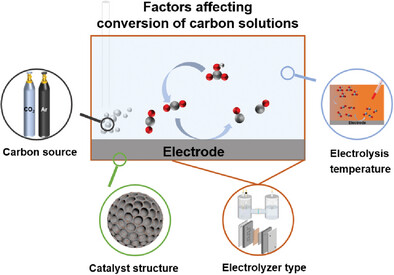
This study unveils the critical factors influencing the electrochemical conversion of bicarbonate solution over Ni single-atom catalysts, including catalyst structure, carbon source, electrolysis temperature, and electrolyzer type. It provides insight into the conversion of various carbon solutions and establishes the connection between the conversion of gaseous CO2 and captured CO2.
Accompanying Bi Clusters as Charge Mediators Effectively Enhance Synergetic Redox of Bi2Sn2O7/ZnIn2S4 S-Scheme Heterostructure Composites
- First Published: 05 February 2025
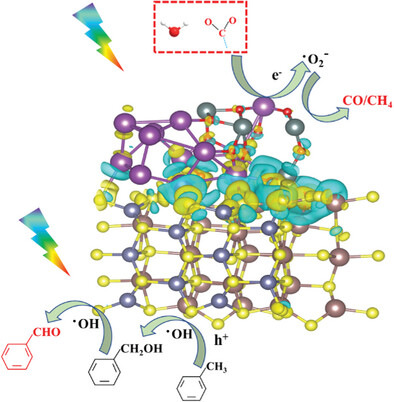
A unique Bi-Bi2Sn2O7/ZnIn2S4 heterostructure is meticulously synthesized through the hydrothermal loading of ultrasmall Bi2Sn2O7 nanoparticles, which feature accompanying Bi clusters on the surface of ultrathin ZnIn2S4 nanosheet layers. This Bi-Bi2Sn2O7/ZnIn2S4 heterostructure demonstrates excellent photocatalytic performance, achieving a CO generation rate of 726.3 µmol g−1 h−1 and oxidizing toluene to benzaldehyde at a rate of 2362 µmol g−1 h−1.
Room-Temperature Synthesis of Amorphous Fe-Doped Nickel Phosphate for High-Efficiency Alkaline Seawater Oxidation
- First Published: 02 February 2025
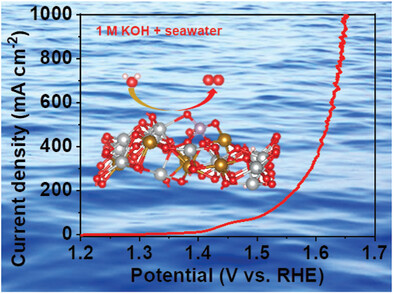
Amorphous Fe-NixPO4 was synthesized through a straightforward co-precipitation method at room temperature. The collaborative interplay between Ni and Fe, along with the decoration of PO43−, can effectively optimize the adsorption of OER intermediates. Consequently, the optimized Fe-NixPO4 exhibits exceptional OER activity, requiring overpotentials of 359 and 422 mV to generate 1000 mA cm−2 in alkaline freshwater and alkaline seawater, respectively.
Dehydroxylated Polyvinyl Alcohol Separator Enables Fast Kinetics in Zinc-Metal Batteries
- First Published: 26 January 2025
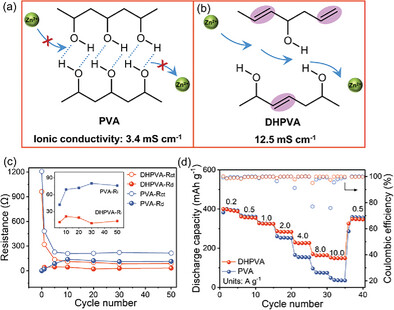
The sluggish ion transport kinetics of PVA arises from the strong hydrogen bonding between the polymer chains. A dehydroxylated PVA (DHPVA) membrane is designed to enable high ionic conductivity, boosted charge transfer, and fast interfacial and diffusion kinetics. As a result, electrochemical performances are demonstrated in Zn/NaV₃O₈ and Zn/I2 full cells.
Iodine Stabilization in Perovskite Lattice for Internal Stress Relief
- First Published: 05 January 2025
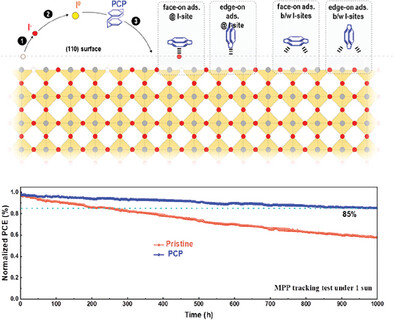
The excellent maximum power point tracking stability of perovskite solar cells is achieved by implementing an iodine stabilization protocol to inhibit perovskite degradation using an additive strategy. The internal stress in the perovskite film is successfully alleviated, resulting in an improved efficiency of 25.26% from 23.93% for perovskite solar cells.
Synergistic Catalysis in Fe─In Diatomic Sites Anchored on Nitrogen-Doped Carbon for Enhanced CO2 Electroreduction
- First Published: 31 January 2025
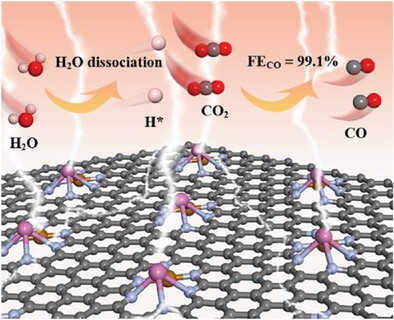
Fe─In diatomic sites anchored on a nitrogen-doped carbon are synthesized for the electrochemical conversion of CO2 to CO. In situ, ATR-SEIRAS and DFT calculations reveal that Fe─In diatomic sites synergistically decrease the energy barrier for *COOH formation. These diatomic sites also stabilize *OH adsorption through a bridging structure, effectively reducing the energy barrier for H2O dissociation and enhancing proton supply, thereby facilitating the CO2 reduction reaction.
Ultra-stable and Sensitive X-ray Detectors Using 3D Hybrid Perovskitoid Single Crystals
- First Published: 28 January 2025
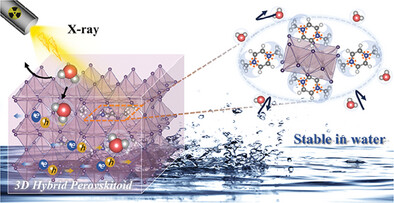
Ultra-stable and highly sensitive X-ray detection is achieved using high-quality bulk single crystals of 3D perovskitoid (DMPZ)Pb2Br6 (DPB, DMPZ = N,N′-dimethyl-pyrazinium), in which N-acidic protons are replaced with hydrophobic alkyl groups. Notably, after 14 days of water immersion, the detectors retain 79.6% of their initial sensitivity, demonstrating exceptional moisture stability.
Cost-Effective RuNi Solid Solutions Prepared by Electrodeposition for Efficient Alkaline Hydrogen Evolution
- First Published: 09 January 2025

A cost-effective RuNi solid solution, with a Ni content exceeding the solubility limit in Ru at room temperature, is prepared by electrodeposition on a Ti substrate. It exhibits excellent HER performance in alkaline media, due to the electron transfer from Ni to Ru that facilitates the desorption of H* from the catalyst surface to produce H2.
Efficient Photocatalytic Water Purification Through Novel Janus-Nanomicelles with Long-Lived Charge Separation Properties
- First Published: 17 January 2025
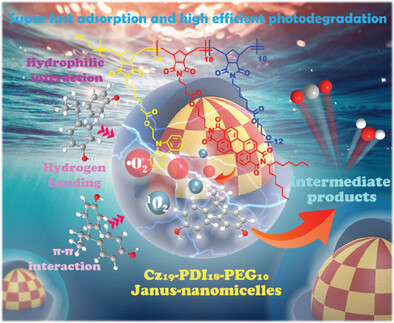
A novel Janus-nanomicelles is prepared by ROMP polymerization. After optimizing the block ratio of donor/receptor, the hydrophilic part of Cz19-PDI18-PEG10 makes the catalyst disperse uniformly in BPA aqueous solution, while the hydrophobic part could enrich BPA rapidly (10 s). Meanwhile, the long-lived charge separation state properties of Cz19-PDI18-PEG10 are capable of efficiently photodegrading BPA (50 ppm) within 120 min for the purpose of water purification.
Highly Conductive, Ultratough, and Adhesive Eutectogels with Environmental Tolerance Enabled by Liquid Metal Composites
- First Published: 16 January 2025
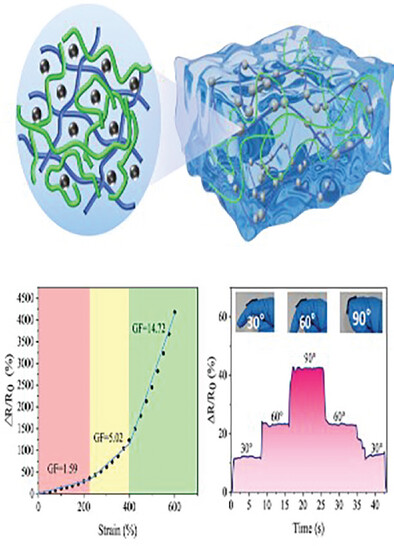
This study reports the design and application of advanced and multifunctional conductive entectogels by employing liquid metal nanoparticle (LMNP)-PEDOT as soft fillers. It is demonstrated that such eutectogels possess high conductivity, toughness, self-healing, enhanced adhesion, and superior environmental tolerance, enabling long-term tracking of human motions and information delivery based on Morse code.
Utilization of Stable and Efficient High-Entropy (Ni0.2Zn0.2Mg0.2Cu0.2Co0.2)Al2O4 Catalyst with Polyvalent Transition Metals to Boost Peroxymonosulfate Activation toward Pollutant Degradation
- First Published: 23 January 2025
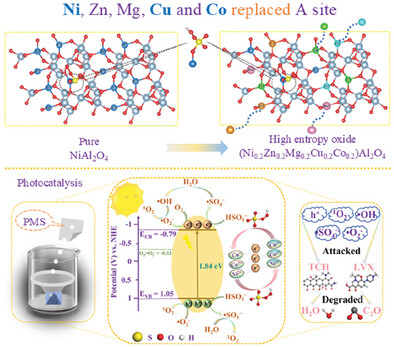
A novel (Ni0.2Zn0.2Mg0.2Cu0.2Co0.2)Al2O4 catalyst is synthesized by the polyacrylamide gel method. The (Ni0.2Zn0.2Mg0.2Cu0.2Co0.2)Al2O4 catalyst exhibits high photocatalytic activity and cyclic stability for the degradation of levofloxacin and tetracycline hydrochloride under the synergistic action of peroxymonosulfate activation and simulated sunlight.
Multi-Functional Responsive Microcapsules with Sequential Release Capacity for Wound Healing
- First Published: 26 January 2025
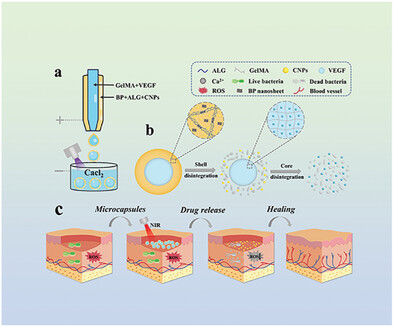
BP-based hydrogel microcapsules, designed for sequential release of active ingredients, provide a versatile solution for wound healing. By combining curcumin's potent antioxidant effects with BP's photothermal antibacterial efficiency under NIR irradiation, these microcapsules offer excellent drug loading and controlled release. This innovative design shows great potential for enhancing wound recovery.
Advanced Functional NiCo2S4@CoMo2S4 Heterojunction Couple as Electrode for Hydrogen Production via Energy-Saving Urea Oxidation
- First Published: 14 January 2025

An all-room temperature approach to create a defect enriched NiCo2S4/CoMo2S4 heterojunction derived from metal organic framework (MOF) is developed. The designed system provides a heterostructure with an inbuilt internal electric field and two regions with opposite charge distribution at the interface, which facilitate electron transfer and enhance bond cleavage of urea molecule during catalysis.
Low-Concentration Flame-Retardant PC-Based Electrolytes for Wide-Temperature and High-Voltage Lithium-Ion Batteries
- First Published: 02 February 2025

A multifunctional electrolyte system is developed through the synergistic interaction of solvent and lithium salt to modulate the solvation structure of propylene carbonate (PC)-based electrolytes, thereby mitigating the co-intercalation behavior of PC. This strategy facilitates reversible cycling of PC-based electrolytes at low lithium salt concentrations, enabling lithium-ion batteries to maintain stable cycling performance.
Elucidating Mesostructural Effects on Thermal Conductivity for Enhanced Insulation Applications
- First Published: 28 January 2025
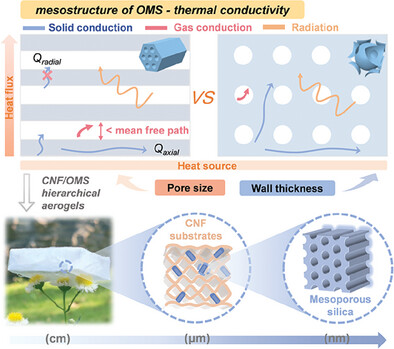
This study compares the thermal conductivity of two ordered mesoporous silica (OMS), hexagonal SBA-15 and cubic SBA-16, to understand mesostructural effects on thermal insulation properties. The influence of structural parameters, including pore size and wall thickness, is also explored. Additionally, multiscale hierarchical porous cellulose nanofibers /OMS aerogels with improved thermal insulation are developed, offering potential for applications.
Visual Location of Oxygen Vacancies on Bismuth Titanate Nanosheets with Periodic Quantum Well and Promoting H2O2 Photosynthesis
- First Published: 10 January 2025
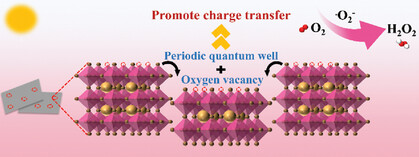
A BTO-OV model is first constructed through DFT calculations to reveal the influence mechanism of periodic quantum well and OVs on the charge transfer behavior in BTO. Importantly, the visual location of OVs on BTO nanosheets is achieved through the iDPC-STEM. Furthermore, the experimental results demonstrate that OVs and periodic quantum well can accelerate charge separation, leading to a 5-fold enhancement in the H2O2 photosynthesis.
Enhancing Interfacial Interactions Through Microwave-Irradiated Reduction for the Recycling of Photovoltaic Silicon Waste for Lithium Storage
- First Published: 21 January 2025
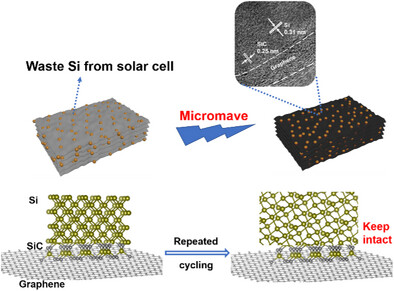
A microwave reduction method is developed for recycling of photovoltaic silicon waste to produce graphene-coated silicon materials (wSi@rGO) for Li-ion battery. The instantaneous high temperature facilitates the formation of interfacial SiC chemical bonds, which strengthen the interaction between Si and graphene, thereby reducing Si delamination. The wSi@rGO anode exhibits remarkable cycling stability in half-cell and full-cells.
Advanced Adaptive Protein Membrane with Super-High Flux and Precise Molecular Sieving of Dyes from Salts
- First Published: 02 February 2025
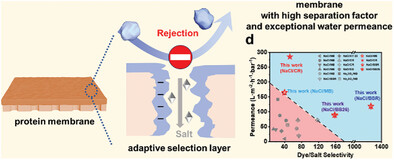
The adaptive protein membrane made from co-assembling lysozyme and hemoglobin achieves super-high flux and precise molecular sieving of dyes from salts. The unique adaptive separation layer can be formed by anchoring dye molecules into the larger pores and thus narrowing down the pore size distribution and enhancing electrostatic repulsion, endowing the membrane with a distinctive molecular sieving of dyes and salts.
In Situ Slow-Release Hydrogen Sulfide Therapeutics for Advanced Disease Treatments
- First Published: 21 January 2025
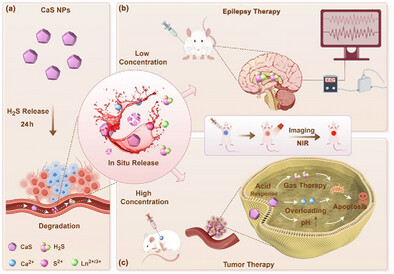
H2S gas therapy garners significant attention for its potential to improve outcomes in various disease treatments. CaS: Eu2+, Sm3+ nanoparticles exhibited approximately three times more effective in treating epilepsy and inhibiting tumors than the NaHS. This innovative slow-release, in situ H2S therapeutics holds the potential to rejuvenate and invigorate the development of H2S-based therapeutics.
Ultrabright and Stable Red Perovskite Nanocrystals in Micro Light-Emitting Diodes Using Flow Chemistry System
- First Published: 27 January 2025
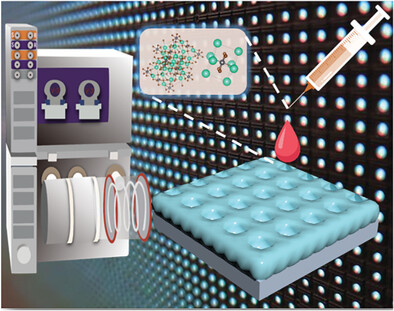
Ultra-bright pure red CsPb(Br,I)3 perovskite quantum dots (PQDs) with well-aligned structures are successfully synthesized using typical ligands (oleic acid (OA) and oleylamine (OAm)) through a flow system. The PQDs exhibit an impressive photoluminescence quantum yield (PLQY) ≈100% with high reproducibility. In addition, by adjusting the reaction flow ratio, ultra-stable and ultra-bright CsPb(Br,I)3@Cs4Pb(Br,I)6 core–shell PQDs are prepared for the first time, with a PLQY exceeding 90%. Subsequently, core/shell PQDs are used in micro-light-emitting diodes devices, showing their potential for applications in the display industry.
Synergistic Enhancement of Ligand & Cluster Connectivity to Construct Highly Stable Fluorescein-Based MOFs with Thickened Channel Walls for Boosting Photocatalytic Activity
- First Published: 20 January 2025
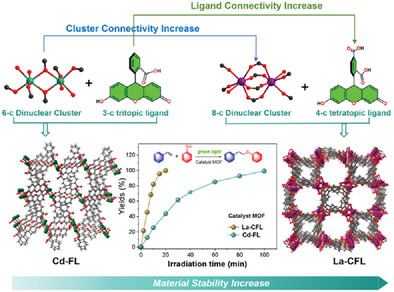
A strategy involving synergistically increased ligand and cluster connectivity to fabricate highly stable fluorescein MOFs is developed resulting in a significant enhancement of the photocatalytic efficiency for the thiol-ene reaction, with the lowest catalyst loading and shortest required reaction time.
Enhancement Mechanism of Photo-Induced Artificial Boundary on Ultrastable Hybrid Solid-electrolyte Interphase of Si Anodes
- First Published: 26 January 2025
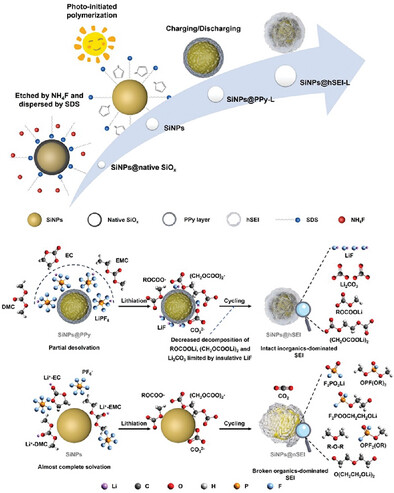
A straightforward and green one-step in situ photo-initiated polymerization strategy is applied for constructing artificial organic SEI precursor for Si particles. Enhancement mechanism of photo-induced artificial boundary on the ultrastable hybrid solid-electrolyte interphase of Si anodes with superior lithium storage is revealed. This work proposes an effective guidance for optimizing the SEI of Si-based anode.
Tailoring a High Loading Atomic Zinc with Weak Binding to Sodium Toward High-Energy Sodium Metal Batteries
- First Published: 10 January 2025
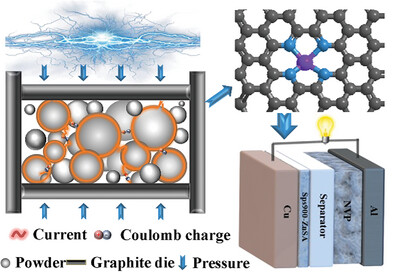
A route is reported to rapidly prepare very high-loading single-atom zinc by boosting the formation kinetics of the Zn-N bond by a multi-physics field coupling route. The abundant atomic Zn acts as active sites through weak binding with sodium to effectively regulate the Na metal nucleation and deposition, leading to a high-energy density anode-free sodium battery.
Water-Deficient Interface Induced via Hydrated Eutectic Electrolyte with Restrictive Water to Achieve High-Performance Aqueous Zinc Metal Batteries
- First Published: 23 January 2025
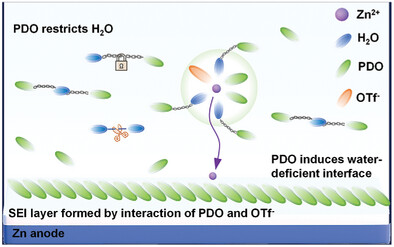
By constructing a hydrated eutectic electrolyte containing 1,3-propanediol (PDO), the interfacial stability in AZMBs can be improved. First, PDO can restrict the movement of water molecules. In addition, PDO decomposes to form an SEI layer, effectively protecting the zinc anode from the attack of water molecules. This strategy can effectively enhance the cycling stability of AZMBs.
Unlocking Peak Efficiency in Anion-Exchange Membrane Electrolysis with Iridium-Infused Ni/Ni2P Heterojunction Electrocatalysts
- First Published: 29 January 2025

This work unveils an advanced Ir single-atom design on a Mott–Schottky-type Ni/Ni2P catalyst, achieving a refined electronic structure and superior catalytic activity. The synergy of single-atom catalysts and heterojunctions enhances electronic modulation, enriching active sites and boosting electrochemical performance. IrSA–Ni/Ni2P achieves low overpotentials (≈192 mV for OER, ≈54 mV for HER) and robust durability, outperforming benchmark catalysts.
Unveiling the Promotion of Sulfides Heterostructure on the Urea Oxidation Reaction: Role of Interface Engineering and Sulfate Adsorption
- First Published: 03 February 2025
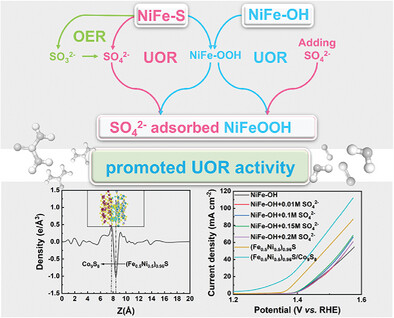
In this study, (Fe0.5Ni0.5)0.96S/Co9S8/NF electrocatalyst with rich heterogeneous interfaces is prepared by electrodeposition and showed significant efficiency and stability in urea oxidation reaction (UOR). Meanwhile, different sulfur conversion pathways are found during the UOR process. The leached sulfur is directly converted into sulfate, which is in stark contrast to the two-step conversion observed in the oxygen evolution reaction (OER).
Synchronous Regulation of Charge Transfer and Defects in Perovskite Nanocomposite Films for Enhanced Sensitivity and Stability in Monolithically Integrated X-Ray Imaging Arrays
- First Published: 31 January 2025
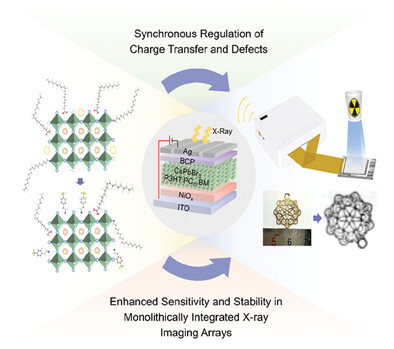
The long-chain ligands on perovskite nanocrystals (PNCs) are partially replaced with short-chain counterparts, resulting in a lower defect density, enhanced carrier transport, and suppressed ion migration simultaneously. The modified PNCs are then combined with organic bulk heterojunction to construct the nanocomposite X-ray detectors, which demonstrate high sensitivity, a stable dark current baseline, and excellent X-ray imaging performance.
Gelatin-Induced Synthesis of Strain-Engineered Spherical Cu2O Nanoparticles for Efficient Nitrate Reduction to Ammonia
- First Published: 29 January 2025
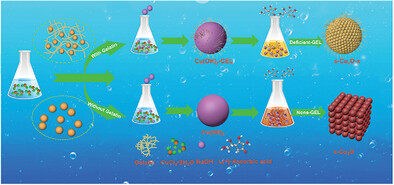
Spherical Cu₂O nanoparticles (s-Cu₂O) with compressive strain effects are synthesized via a gelatin-assisted method, achieving 95.07% Faradaic efficiency for nitrate-to-ammonia conversion. Structural studies and density functional theory reveal strain-modulated electronic properties enhancing selectivity of nitrate reduction reaction, while suppressing hydrogen evolution, with potential applications in sustainable nitrogen cycling and Zn-NO3- batteries.
A Simple and Efficient Non-Noble Cathode Catalyst Based on Carbon Hollow Nanocapsules Containing Cobalt-Based Materials for Anion Exchange Membrane Water Electrolyzer
- First Published: 03 February 2025

This study demonstrates the new preparation of hollow carbon capsules as cathode materials for demonstrating the anion exchange membrane (AEM) water electrolyzer applications. The fabricated AEM water electrolyzer device delivers excellent analytical performance with high current density and long-term stability.
A Versatile Dual-Responsive Shape-Memory Gripper via Additive Manufacturing Toward High-Performance Cross-Scale Objects Maneuvering
- First Published: 24 January 2025
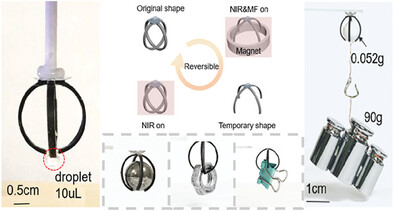
Dual-responsive shape memory gripper integrates photothermal and magnetic responsiveness, enabling remote, precise manipulation of diverse materials across scales. Innovative fabrication ensures adaptability, repeatability, and stability, representing a breakthrough in soft robotics for versatile applications.
Dual-Source Evaporation Processed Novel NaBiS2 Absorber Material for Eco-Friendly and Stable Photovoltaics
- First Published: 28 January 2025
Controllable Detachment of Organic Ligands on Ultrathin Amorphous Nanosheets Tailors the Electron-Aggregation for Accelerated pH-Universal Hydrogen Reaction
- First Published: 02 February 2025
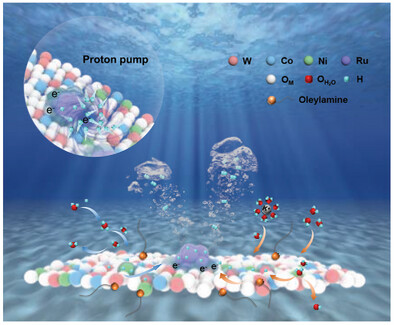
Ultrathin amorphous WCoNiO nanosheet substrates provide abundant sites for Ru in situ growth and organic Lewis based oleylamine ligand coordination. The design of electron-rich microenvironment induced by oleylamine (OLA) plays a key role in the accelerate generation, migration and aggregation of intermediate hydrogen around active sites to largely enhance the pH-universal hydrogen evolution reaction (HER) activity with exceptional mass activity and durability.
Editor's Choice
Compatible Interfaces Constructed by Surficial Indiumization on Garnet Solid Electrolyte for Long-Cycling All-Solid-State Lithium Metal Battery
- First Published: 05 February 2025

A stable LiInO2 ion-conductor layer is formed on the garnet electrolytesurface by surface indiumization, which inhibits the dehydrofluorination of the polymer electrolyte. Meanwhile, this contributes to the construction of a solid electrolyte interphase between the composite electrolyte and the lithium metal anode with LiF and Li3N as the main phases, and ultimately enabling the realization of high-cycle stability all-solid-state batteries.
Emission Tuning of Nonconventional Luminescent Materials via Cluster Engineering
- First Published: 27 January 2025
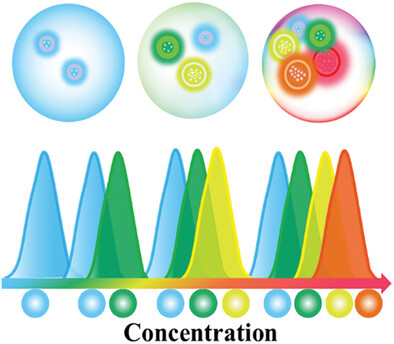
The size of clusters formed by unconventional luminescent materials is tuned by adjusting their concentration. A strong correlation is observed between cluster size and excitation wavelength dependence. Furthermore, aggregation-caused quenching (ACQ) is discovered in these materials. The results indicate that ACQ is attributed to the enhanced through-space conjugation within larger clusters, facilitating exciton diffusion and leading to non-radiative decay.
All-Inorganic Lead-Free Cs₂AgBiBr₆/ZnO Artificial Retina Synapse Based on Photoelectric Synergistic Dual-Mechanism for Neuromorphic Computing
- First Published: 02 February 2025
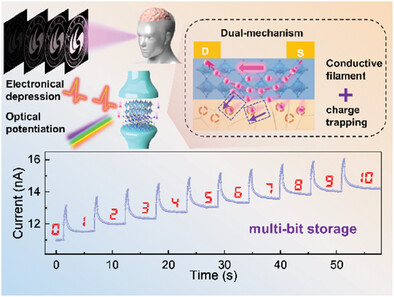
All-inorganic lead-free Cs₂AgBiBr₆/ZnO dual-mechanism non-volatile memory successfully stimulates the learning and forgetting behavior via the synergetic modulation of optical excitatory and electronic inhibitory. The synergetic mechanisms of conductive filament and charge trapping are beneficial for the multi-bit storage at ultralow energy consumption via a variation of light spikes.
Platinum/(Carbon-Nanotube) Electrocatalyst Boosts Hydrogen Evolution Reaction in Acidic, Neutral and Alkaline Solutions
- First Published: 27 January 2025

A carbon-nanotube-supported platinum (Pt) catalyst with 1 wt.% Pt fabricated by using a room-temperature H2-free discharge-driven reduction method exhibits higher efficiency in the electrocatalytic hydrogen evolution reaction than the commercially used Pt/C catalyst with 20 wt.% Pt, not only in acidic solutions but also in neutral and alkaline solutions. This offers great potential for commercialization.
Decoding Framework Dynamics in a Spin Crossover Flexible Metal–Organic Framework
- First Published: 03 February 2025
Enhanced Activity and Stability for Electrocatalytic Nitrate Reduction to Ammonia over Low-Coordinated Cobalt
- First Published: 31 January 2025
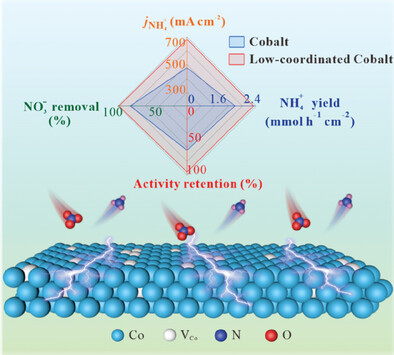
Low-coordinated cobalt nanosheets (L-Co NSs) with abundant cobalt vacancies can enhance both the activity and stability for the electrocatalytic reduction of nitrate to ammonia. L-Co NSs also exhibit favorable performance in removing nitrate from simulated wastewater and air plasma discharge-electrocatalytic reduction cascade system to produce ammonia.
Thermoelectric Properties of a Light Compound Fe2S2: the Role of Electron Correlation Strengthened Spin-Orbital Coupling
- First Published: 13 January 2025

Based on first-principles calculations and Boltzmann transport theory, the electron correlation induced strong spin-orbital-coupling in light 2D material Fe₂S₂ is found to significantly renormalizes the band structures, which triggers giant improvement of thermoelectric performance, giving rise to extraordinary average figure of merits above 1.0 for both p- and n-type near room-temperature region.
Modulating Electronic Density of Single-Atom Ni Center by Heteroatoms for Efficient CO2 Electroreduction
- First Published: 24 January 2025
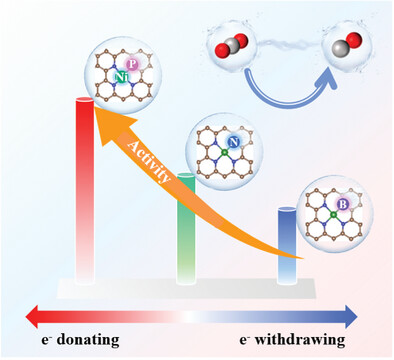
The electronic density of Ni1 single-atom centers is quantitatively regulated by introducing electron-rich phosphorus or electron-deficient boron for electrochemical CO2 reduction. The electron-rich Ni1-N3P catalyst exhibits superior activity and promising stability compared to the Ni1-N4 and Ni1-N3B configurations. Incorporating P dopant facilitates the electronic localization around the Ni1 site and enhances CO2 adsorption and formation of key *COOH intermediate, thus boosting performance.
Solar Evaporator with Dual Gradient Heating Effect for Sustained and Efficient Desalination
- First Published: 15 January 2025
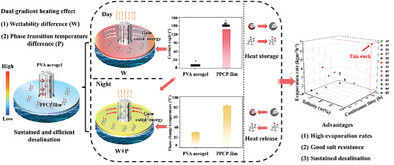
To simultaneously achieve high evaporation rate and improved salt resistance in the evaporator, while effectively mitigating the intermittent solar radiation issue, the evaporator with double gradient heating effect is designed through the wettability difference (hydrophilicity and hydrophobicity) and the difference in phase transition temperature of phase change material for sustained and efficient desalination.
Probing the Active Nitrogen Species in Nitrogen-Doped Carbon Nanozymes for Enhanced Oxidase-Like Activity
- First Published: 16 January 2025
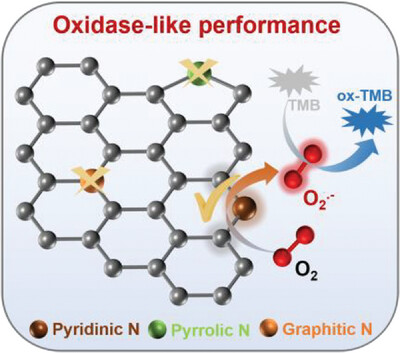
The active nitrogen species for enhancing oxidase-like performance is identified for the first time using nitrogen-doped carbon nanosheets as model nanozymes. Experimental analyses and theoretical calculations reveal pyridinic N is the active nitrogen species that can increase the local charge density of neighboring carbon atoms, accelerate the adsorption and activation of molecular oxygen, and thus enhance oxidase-like activity.




